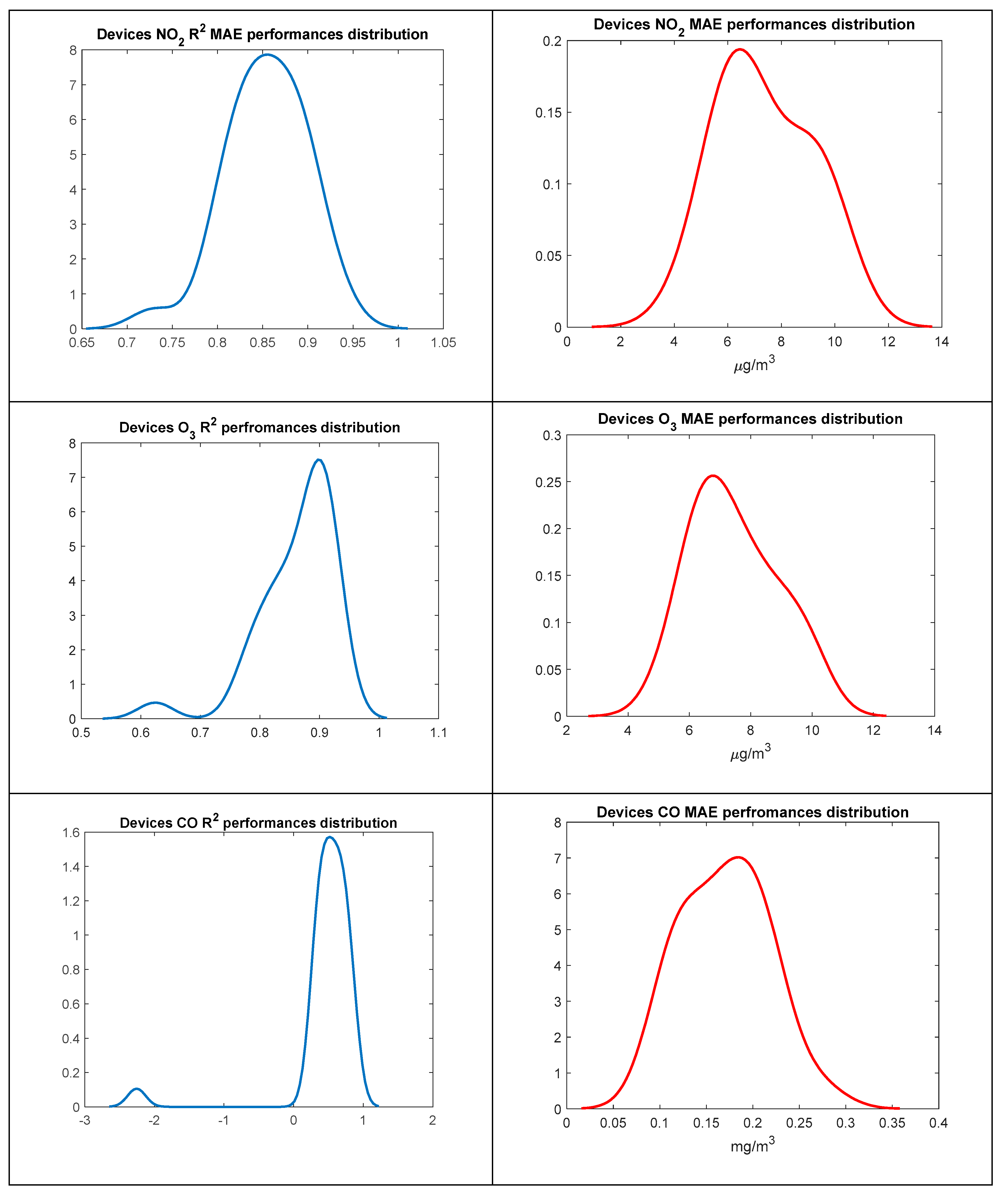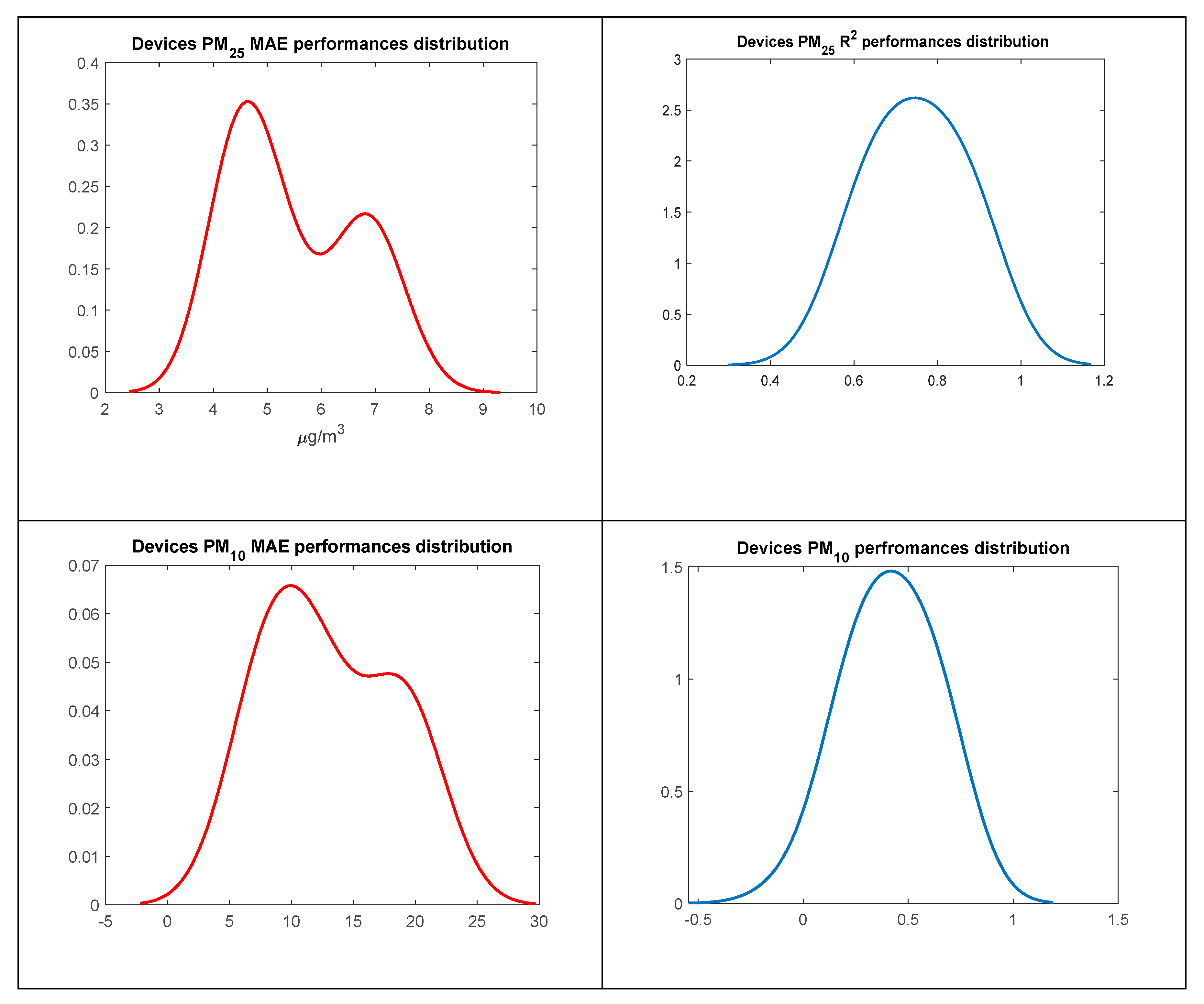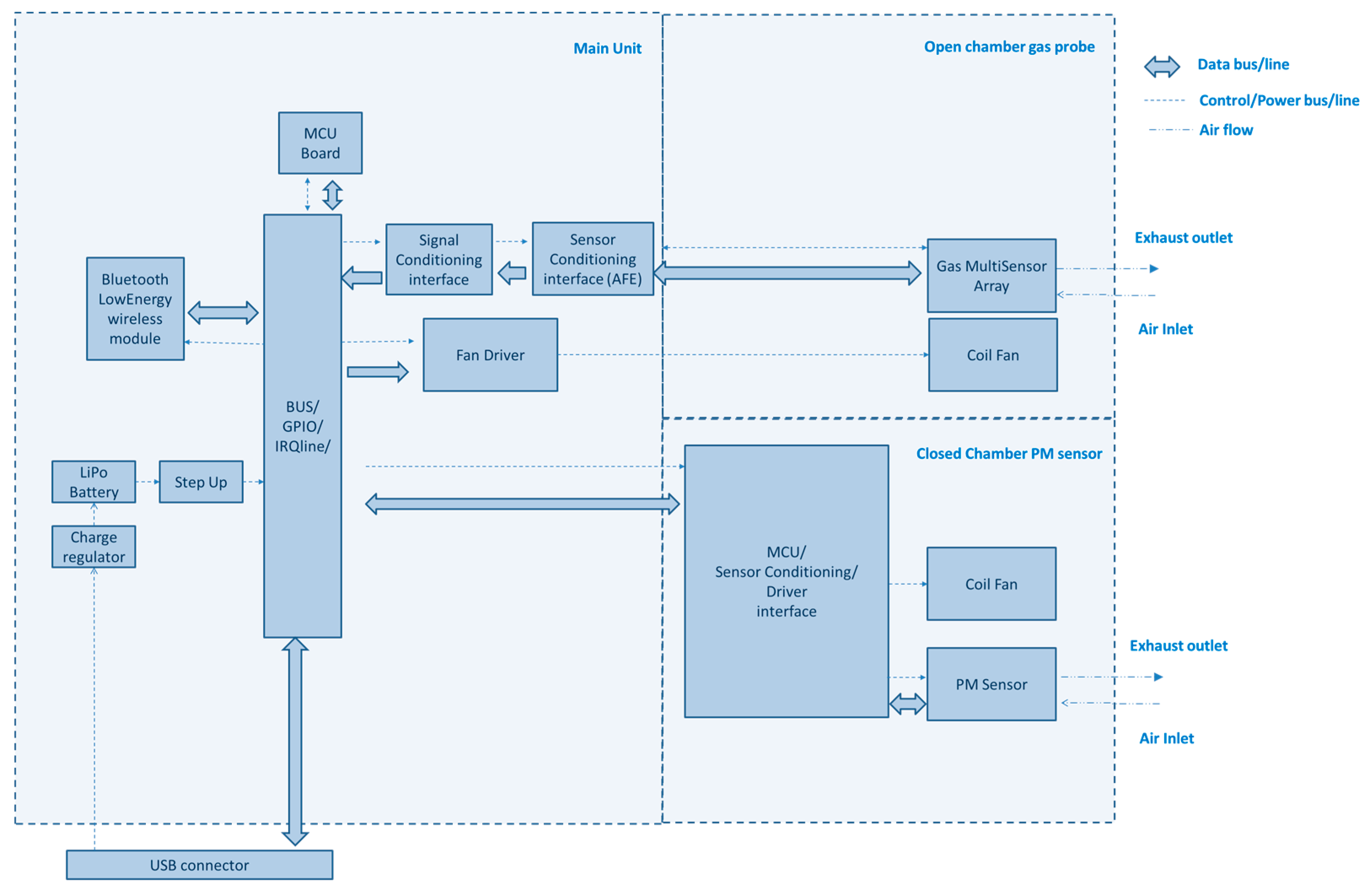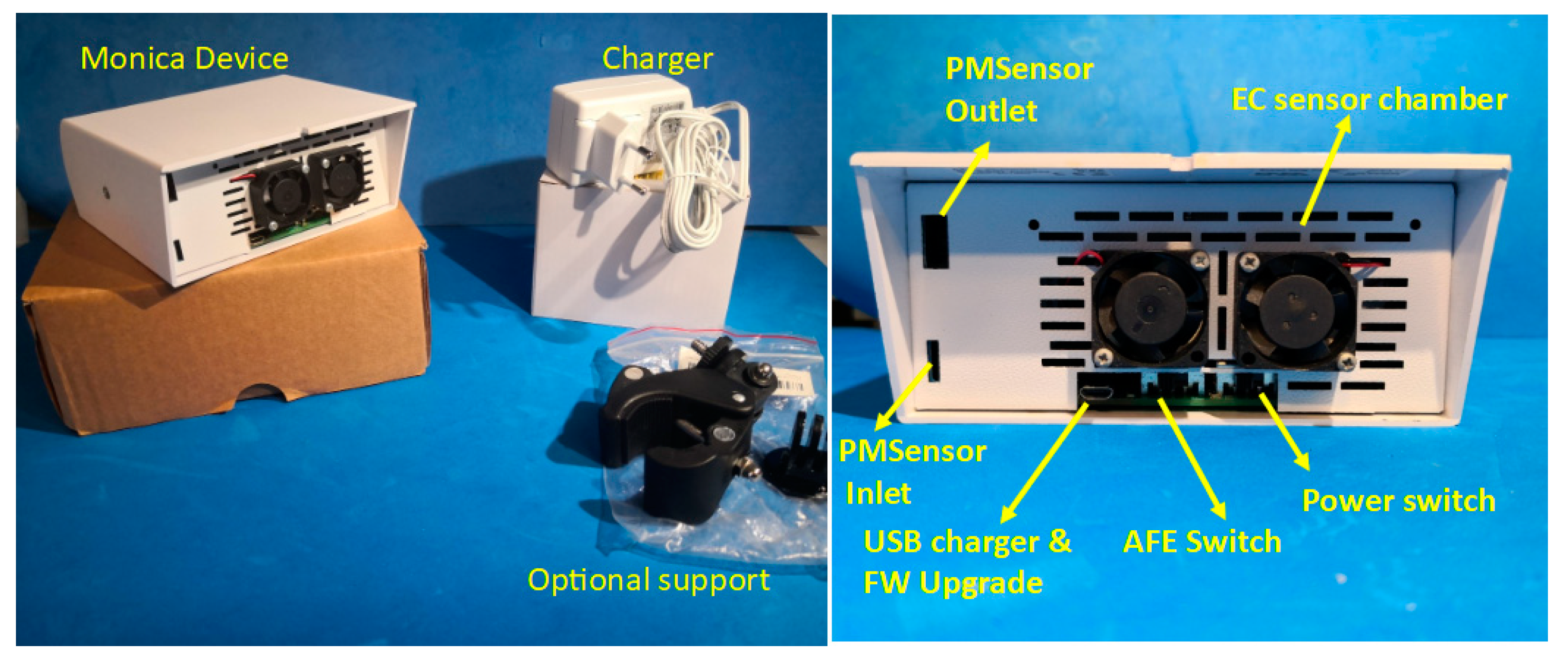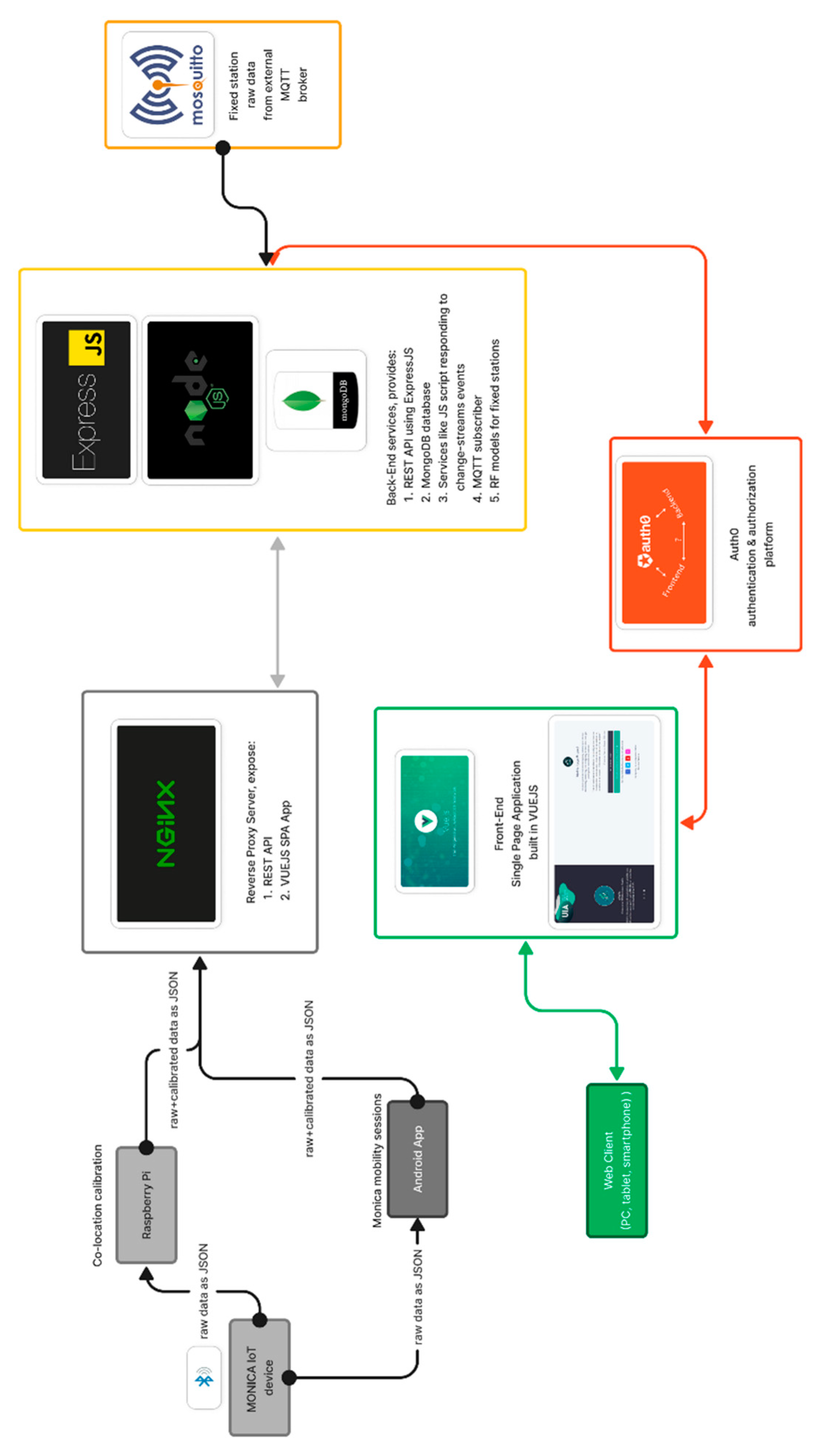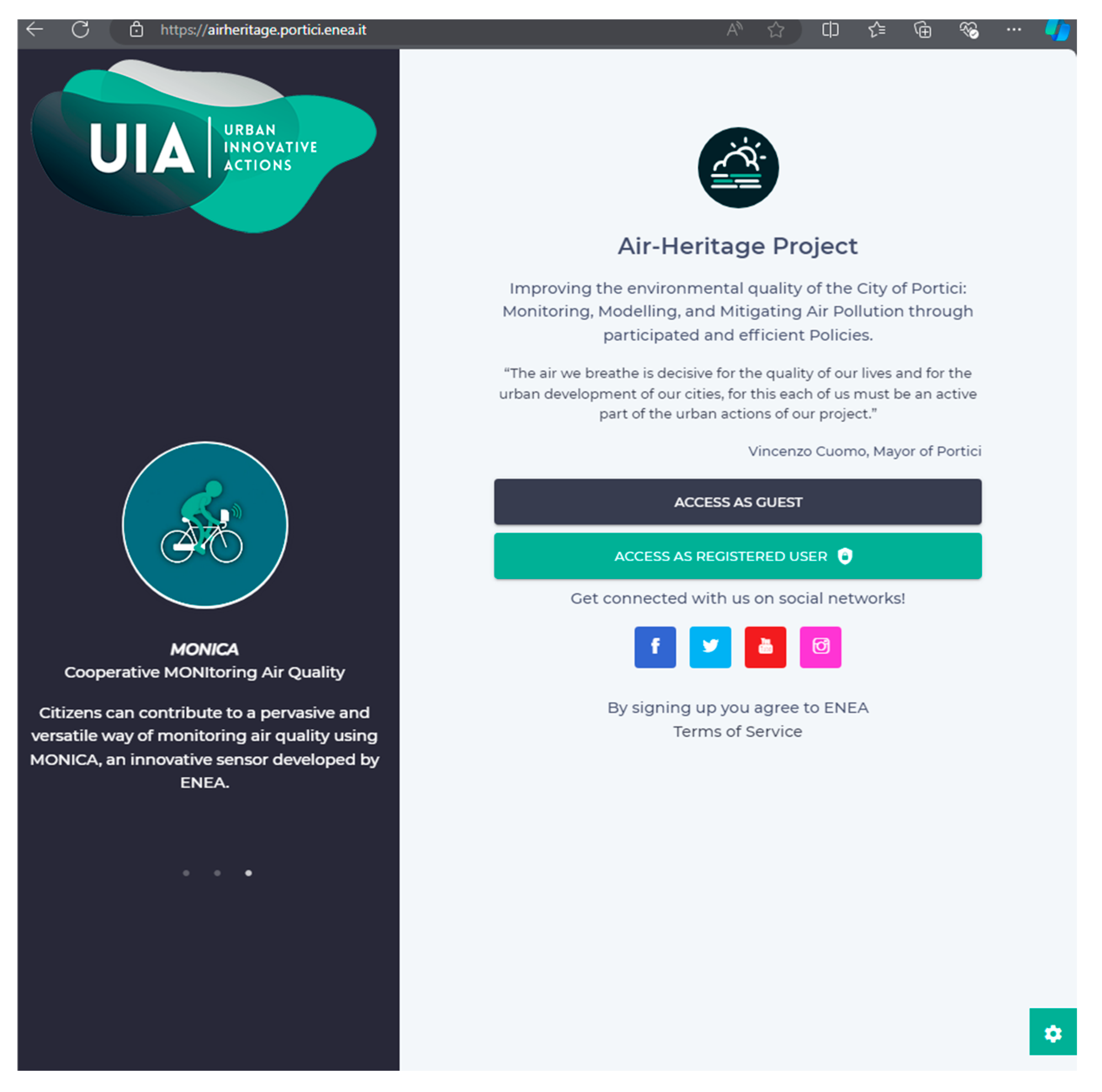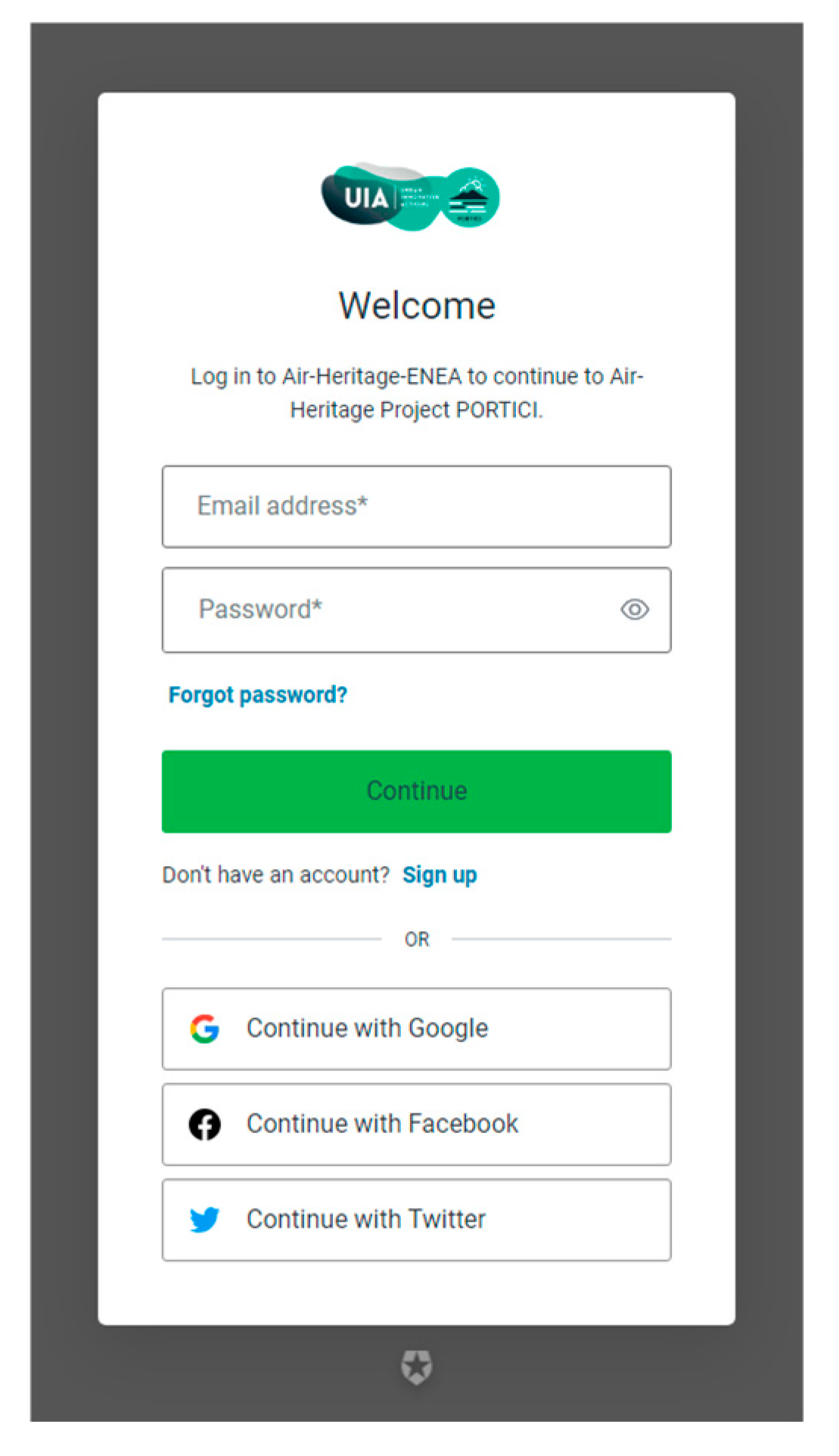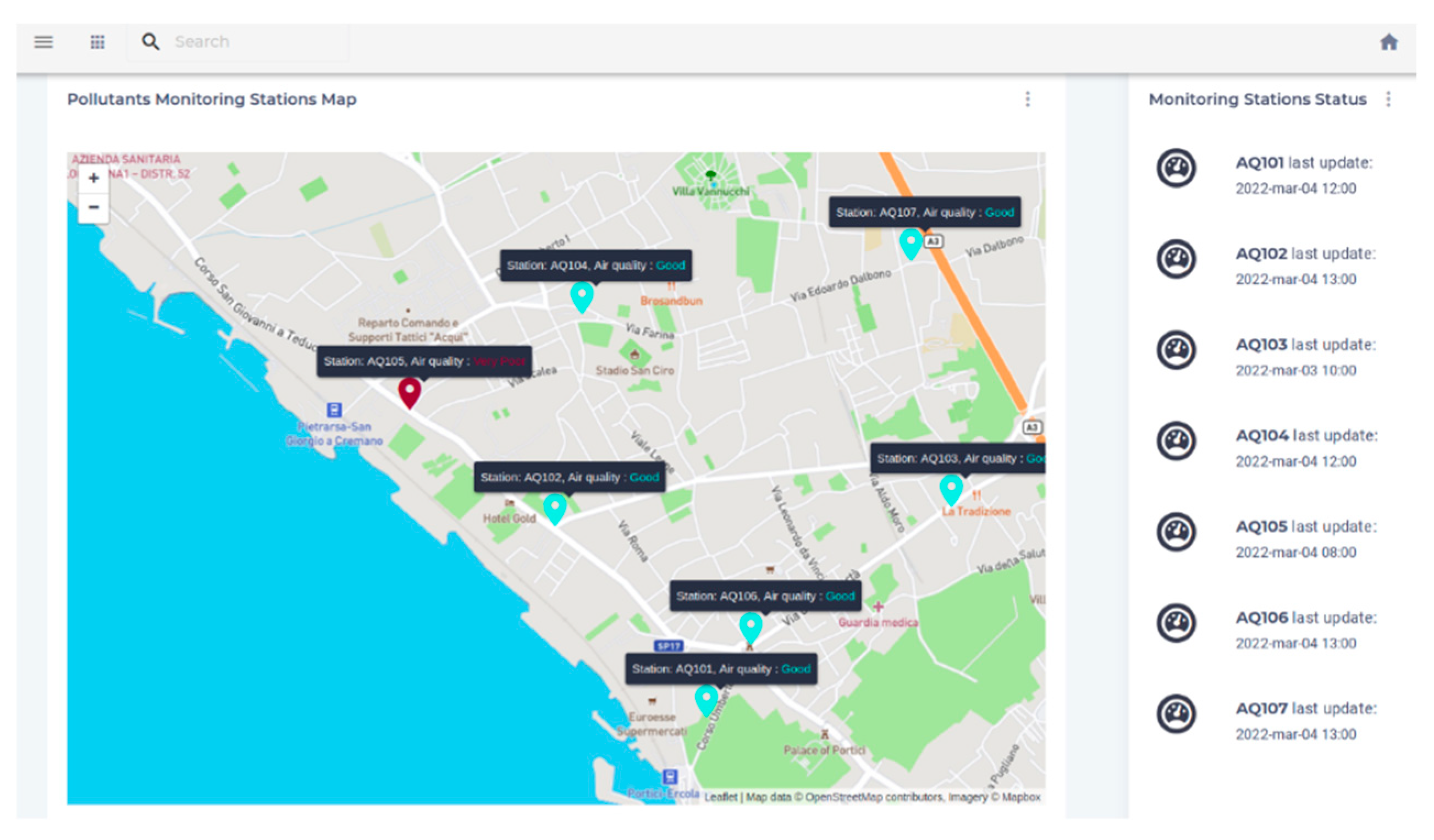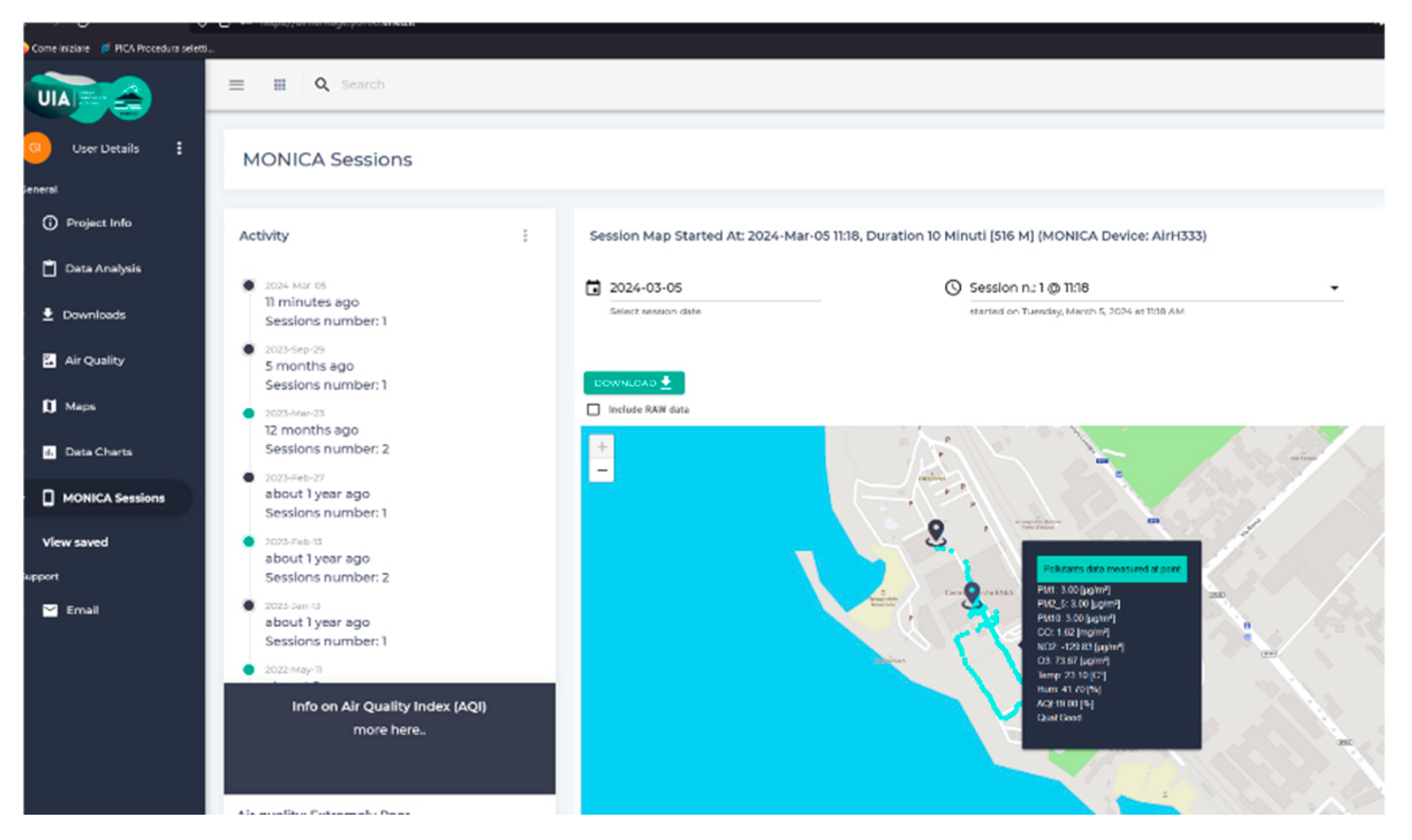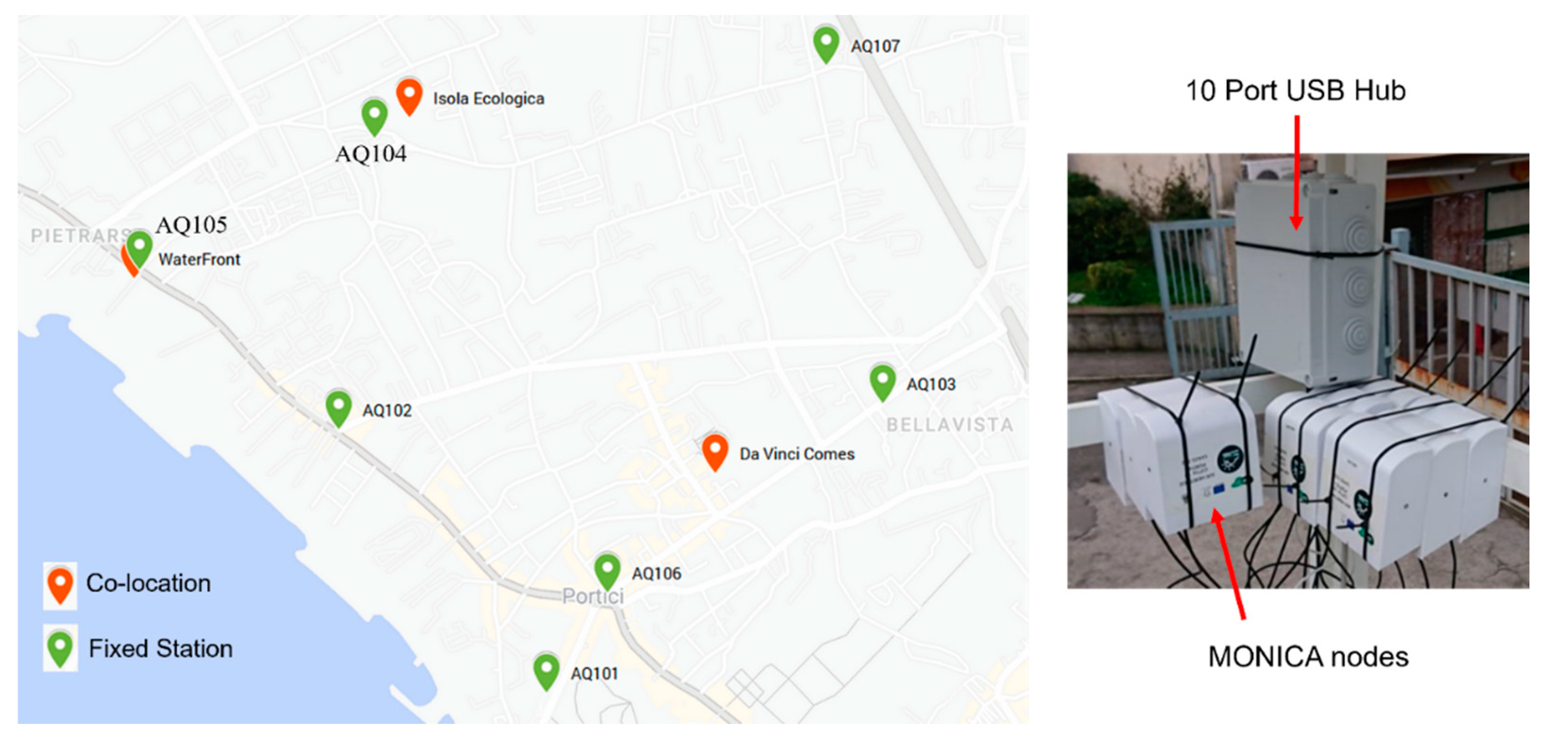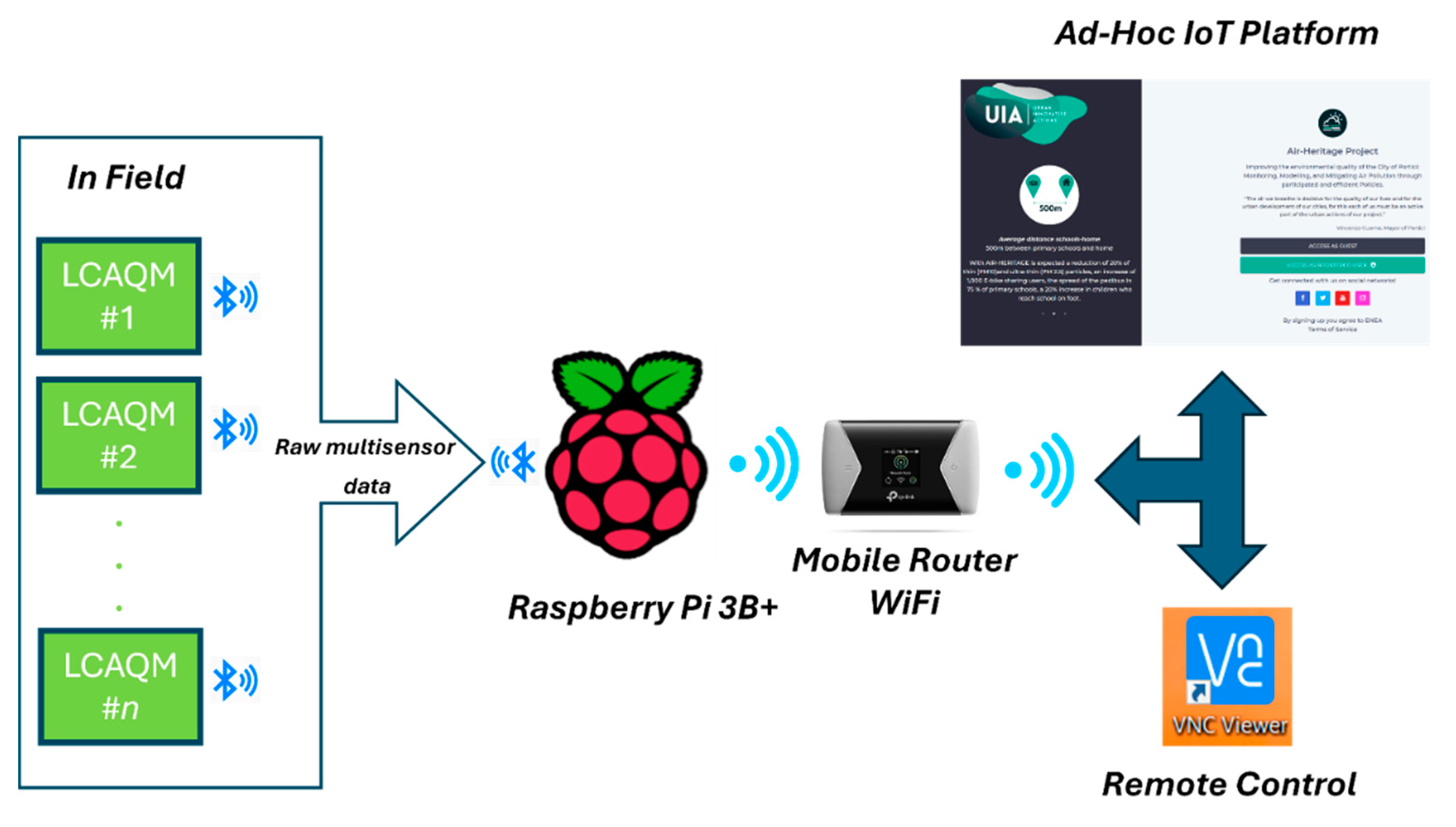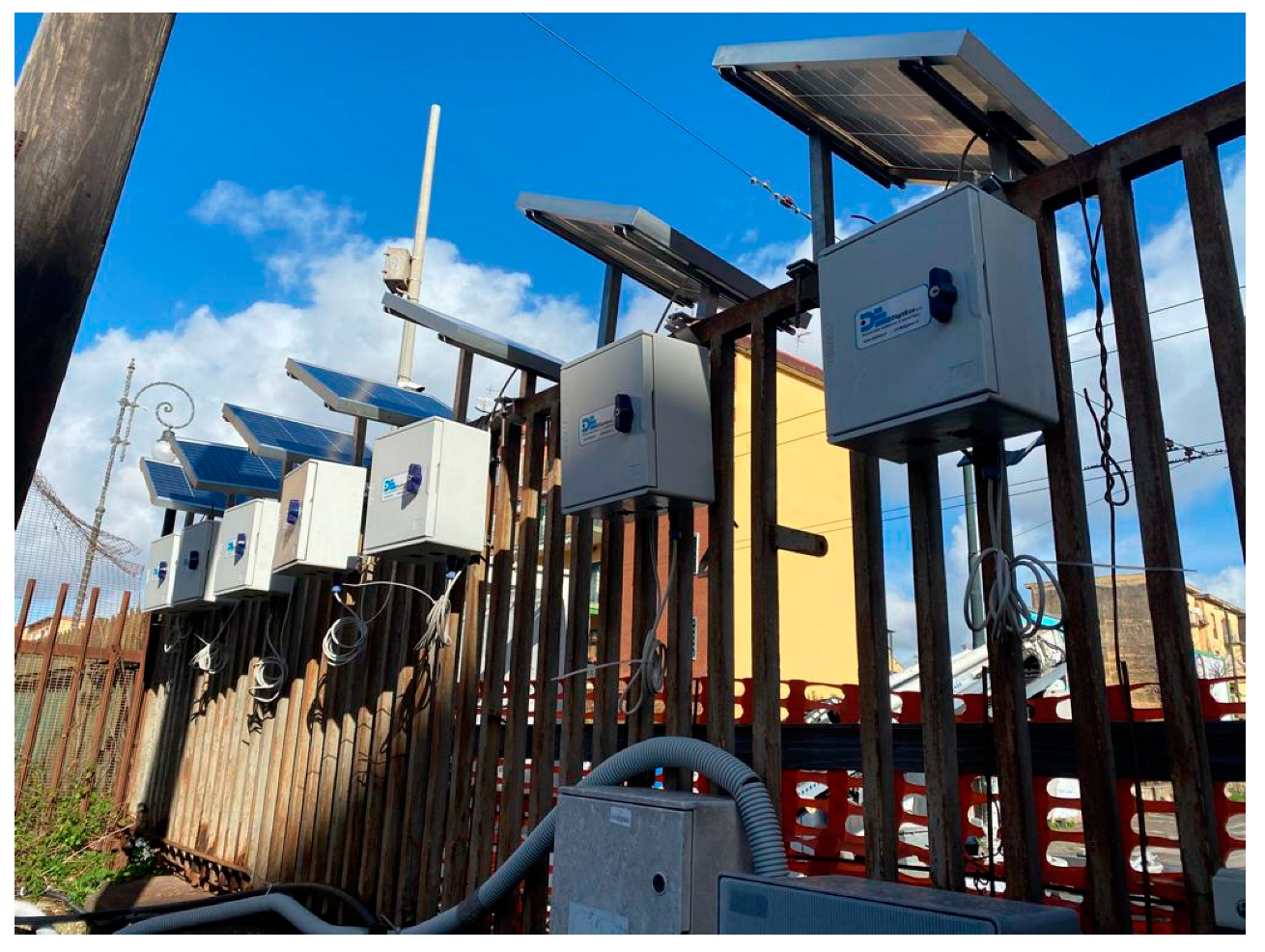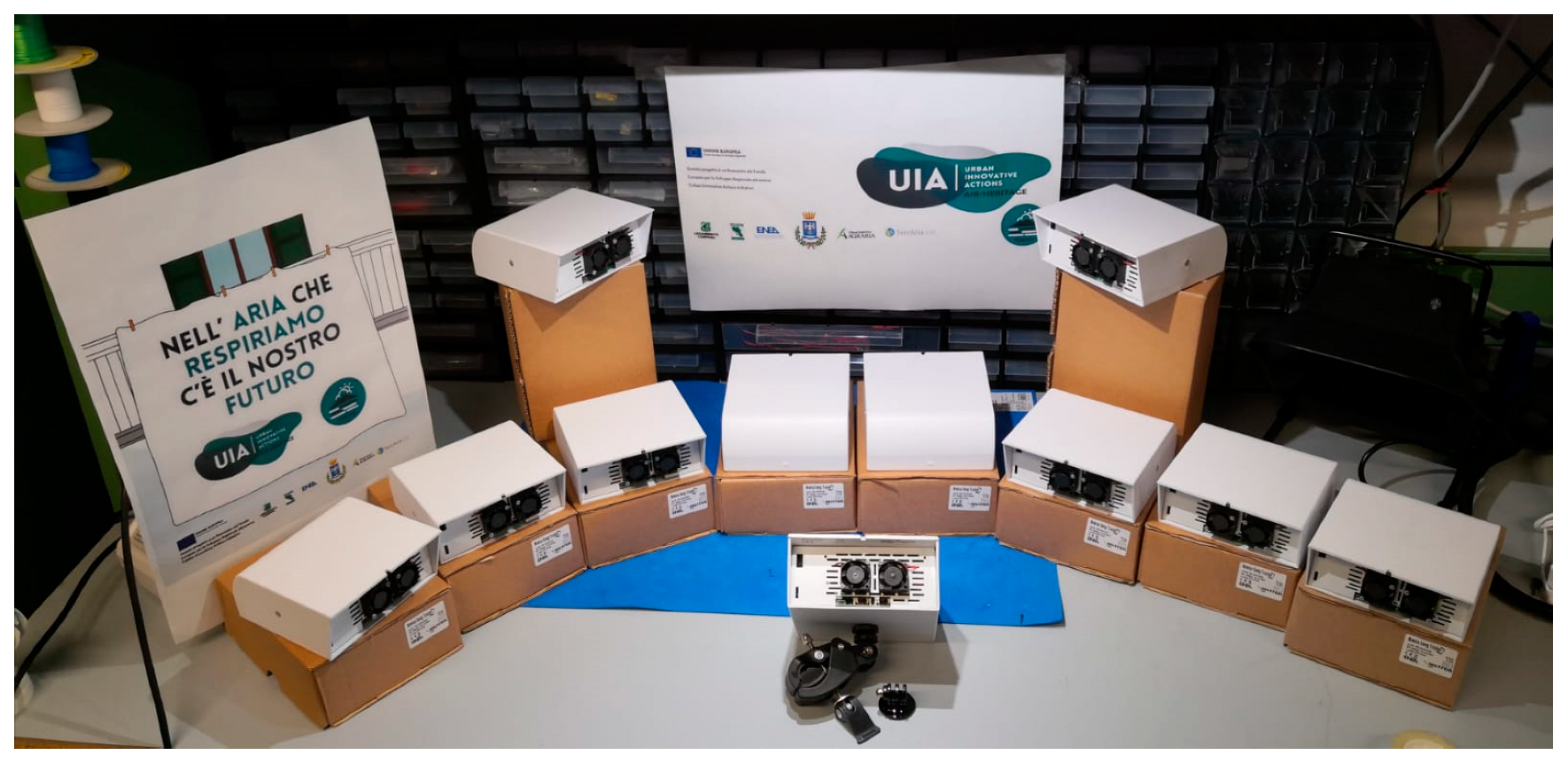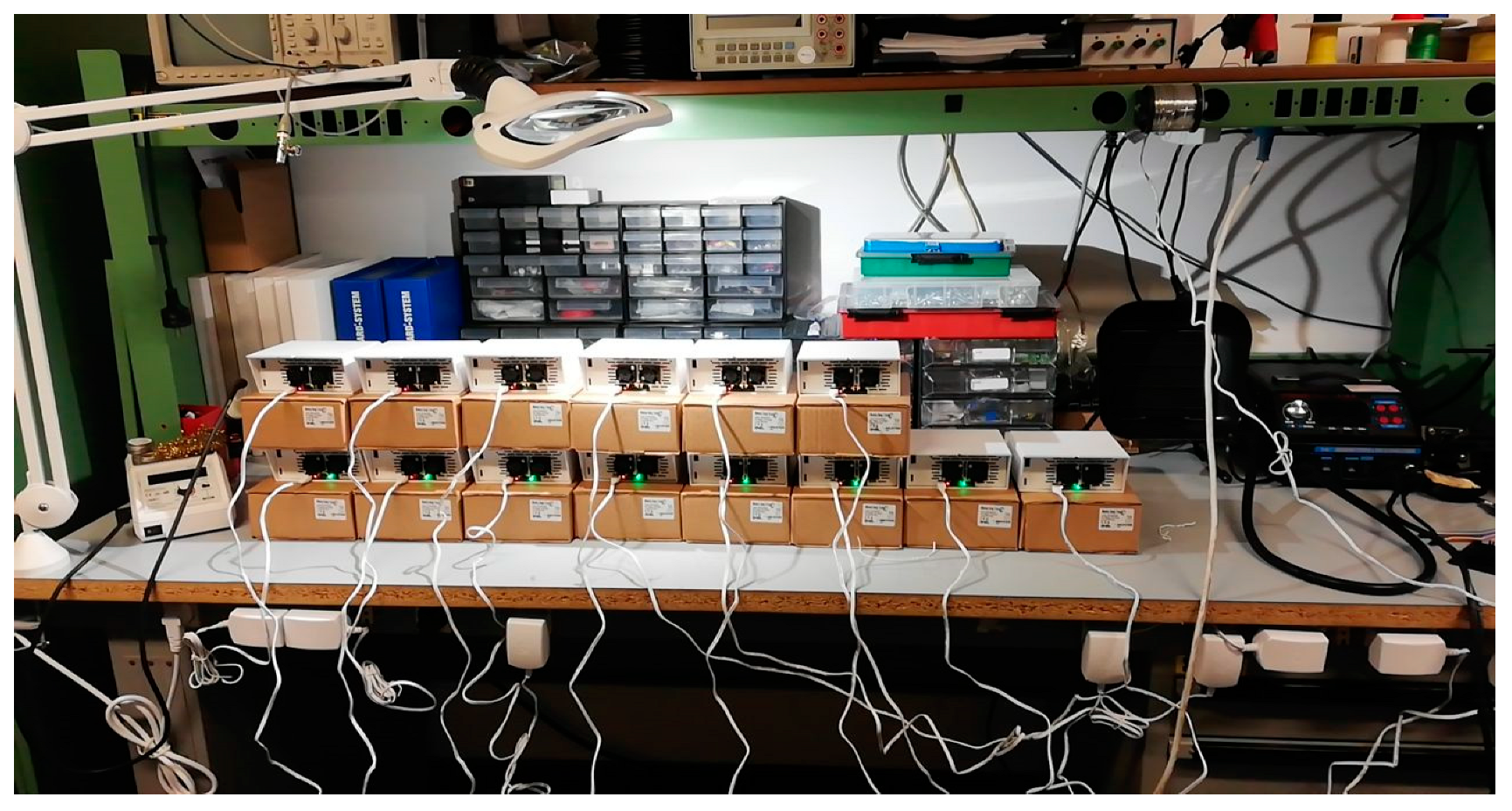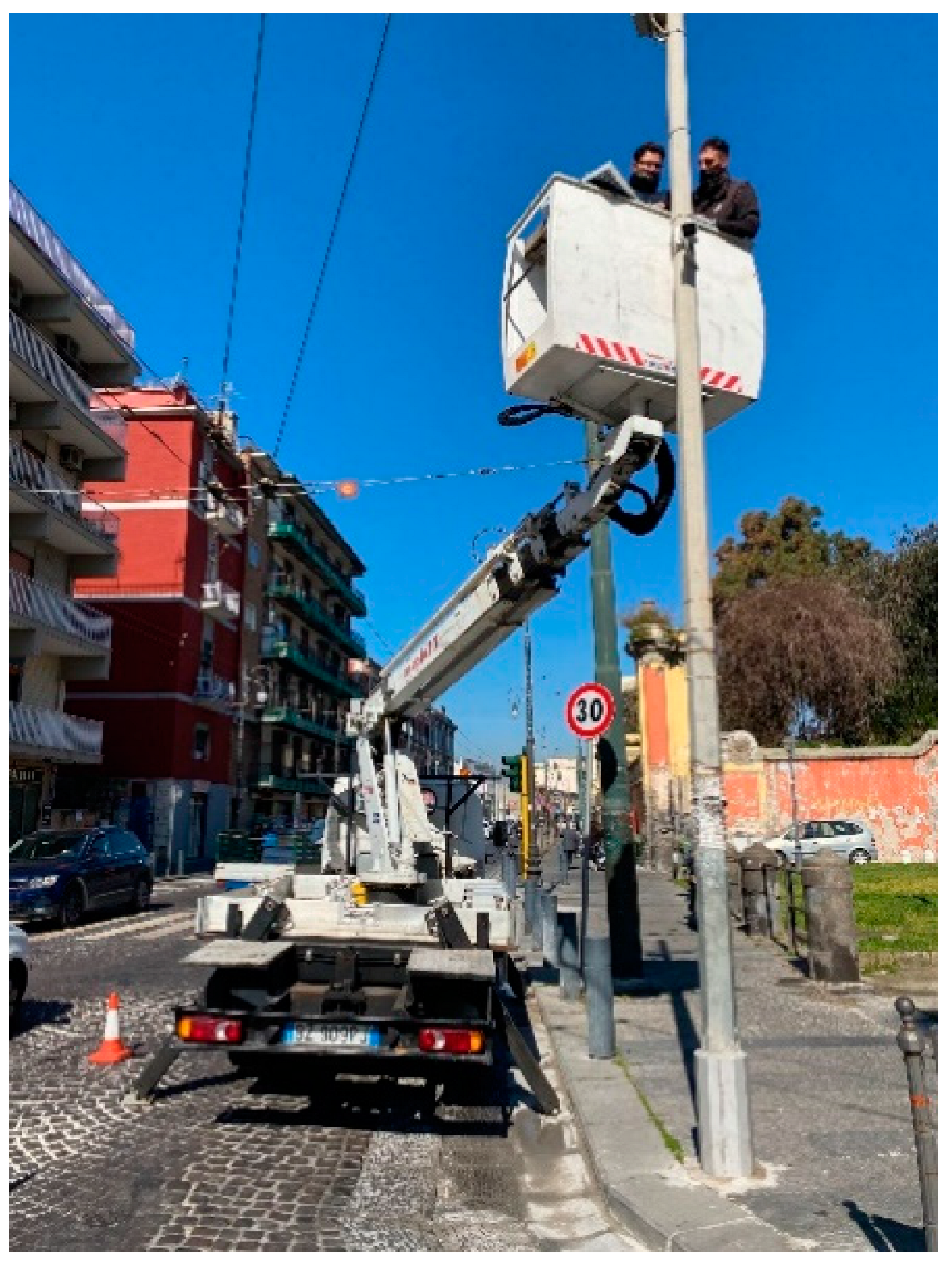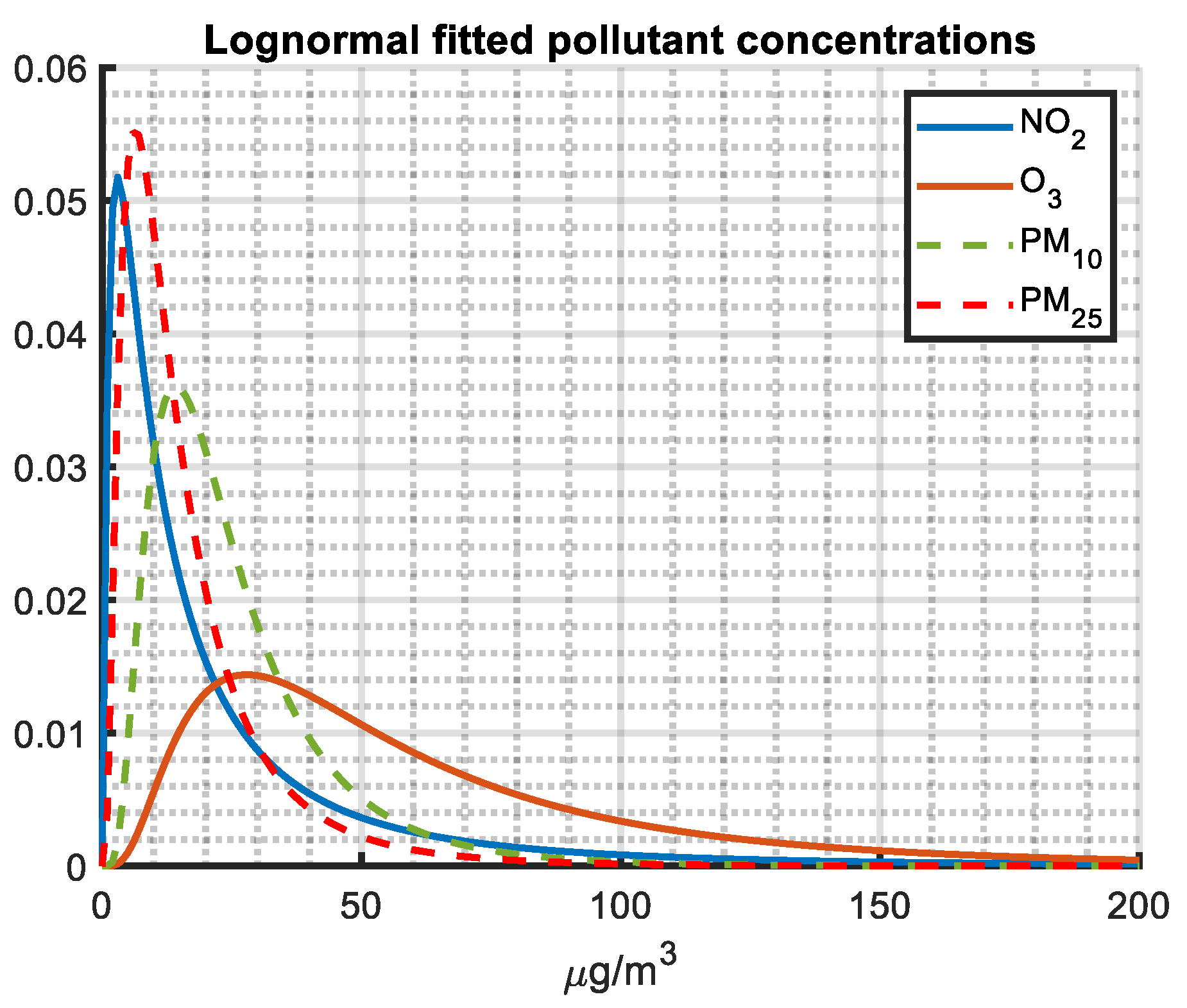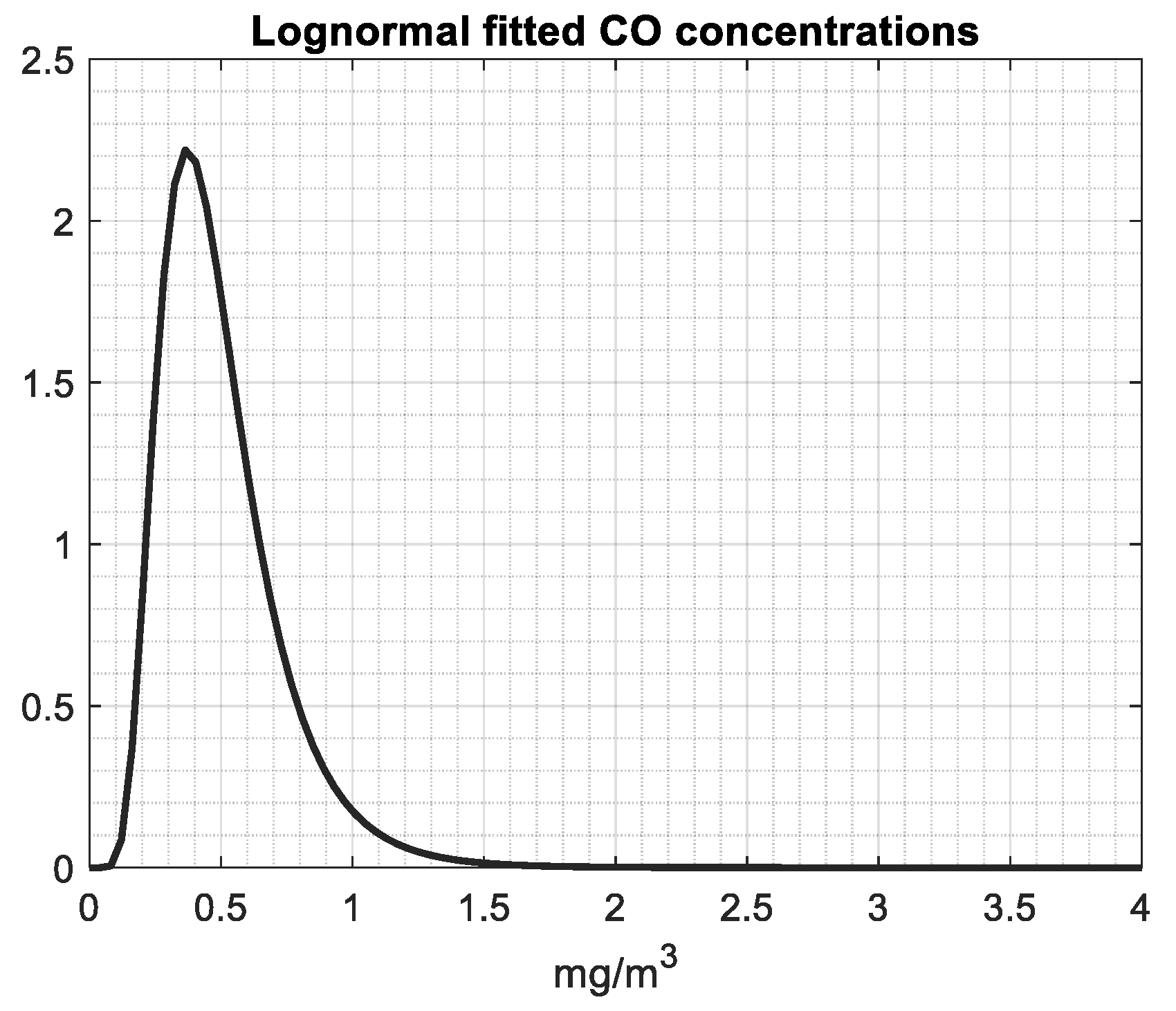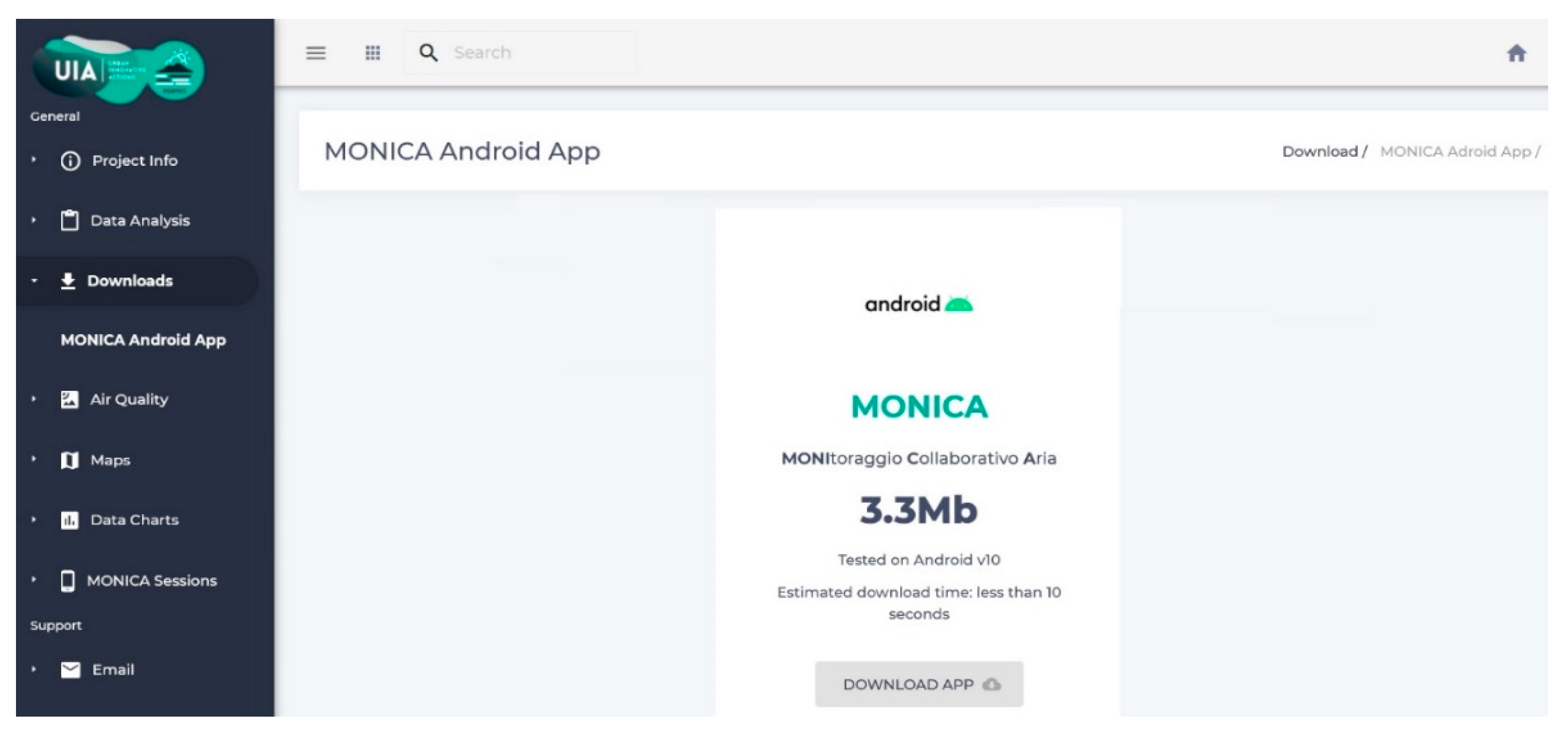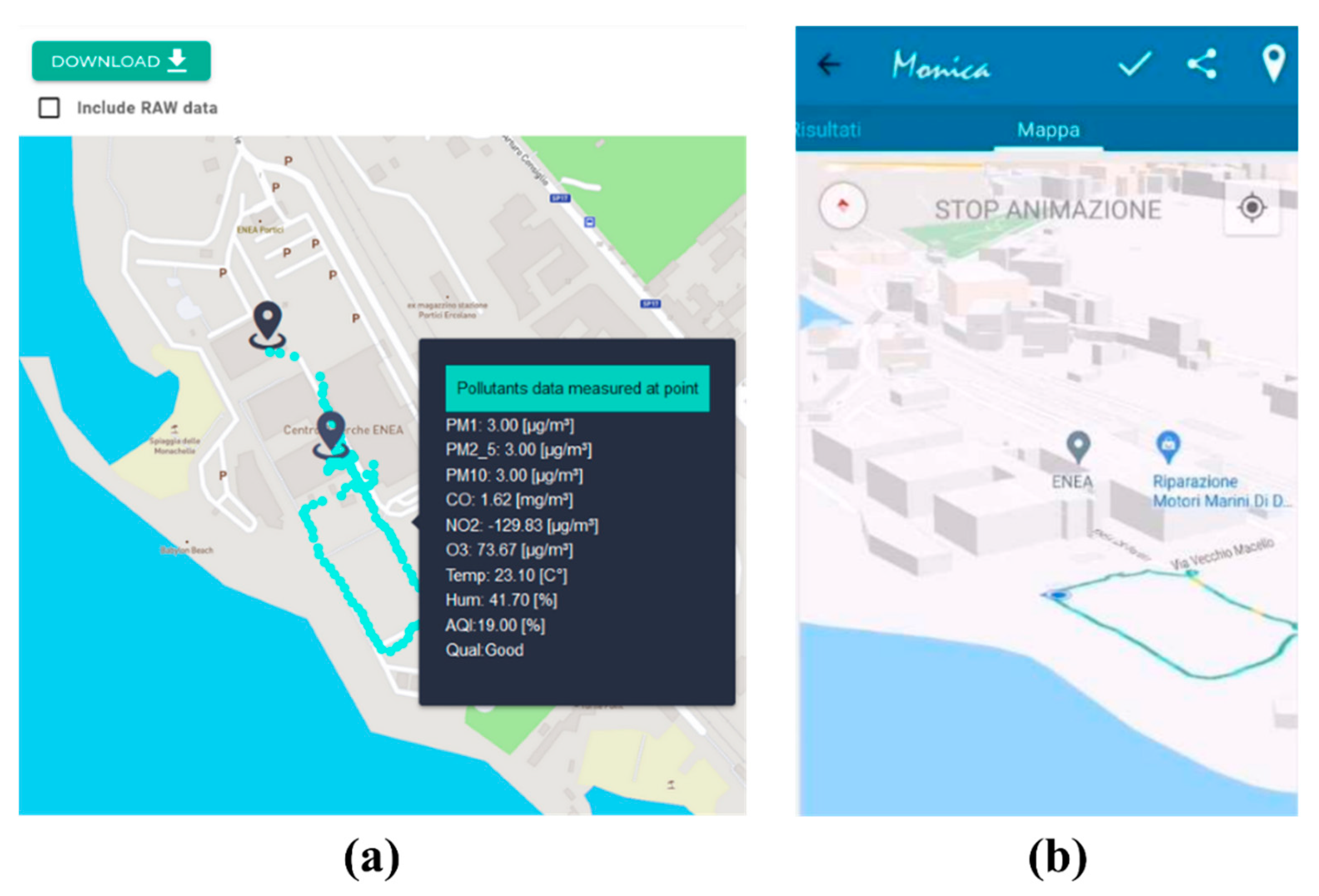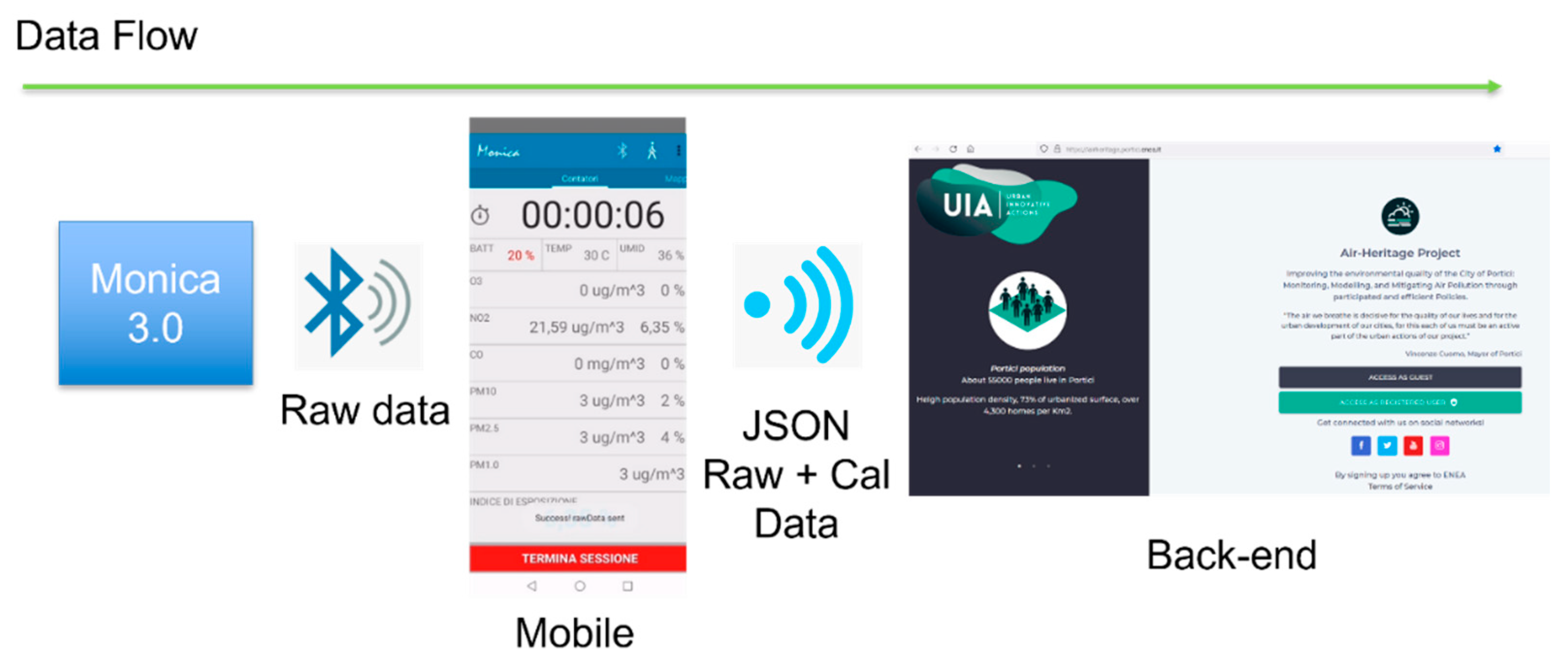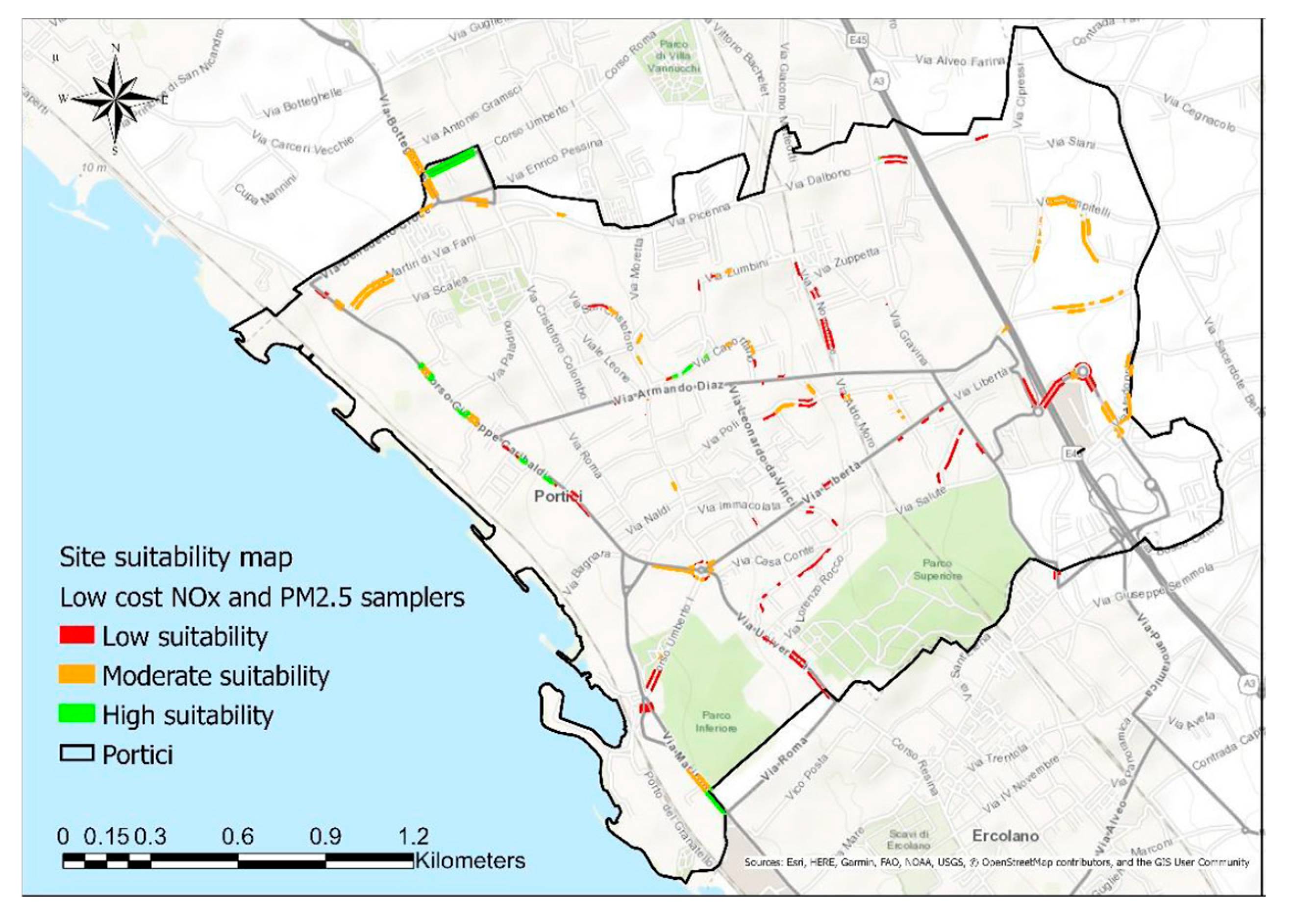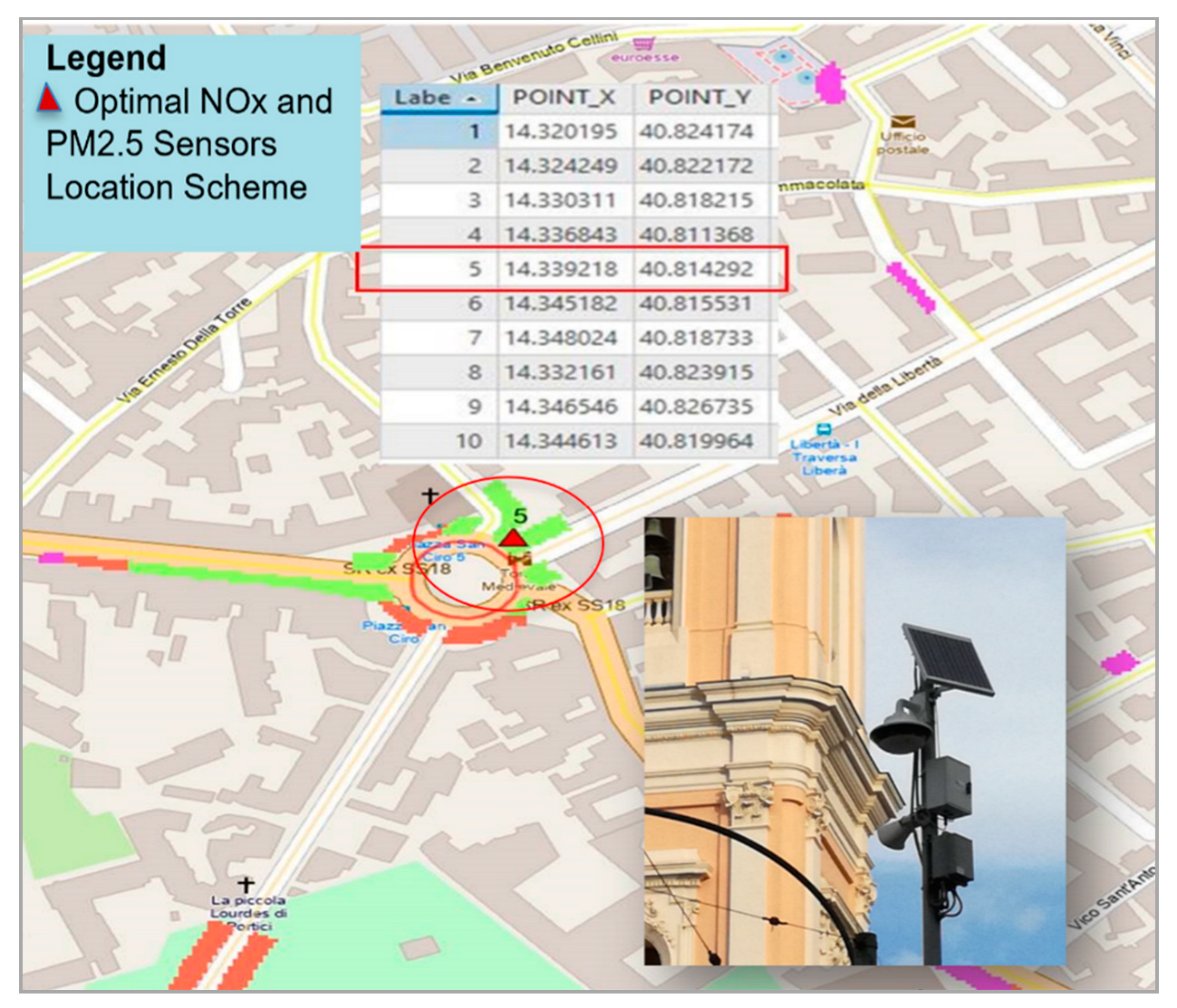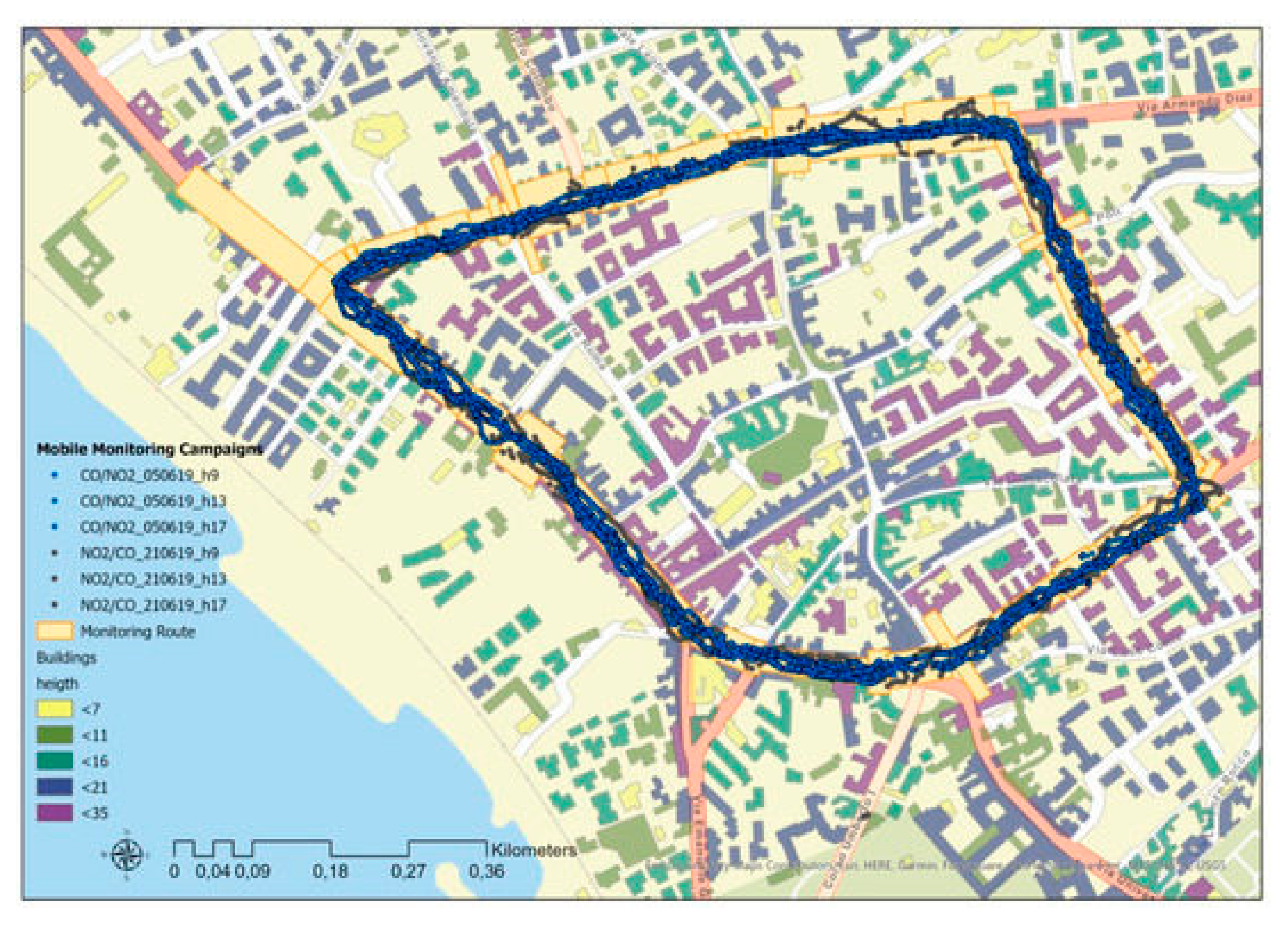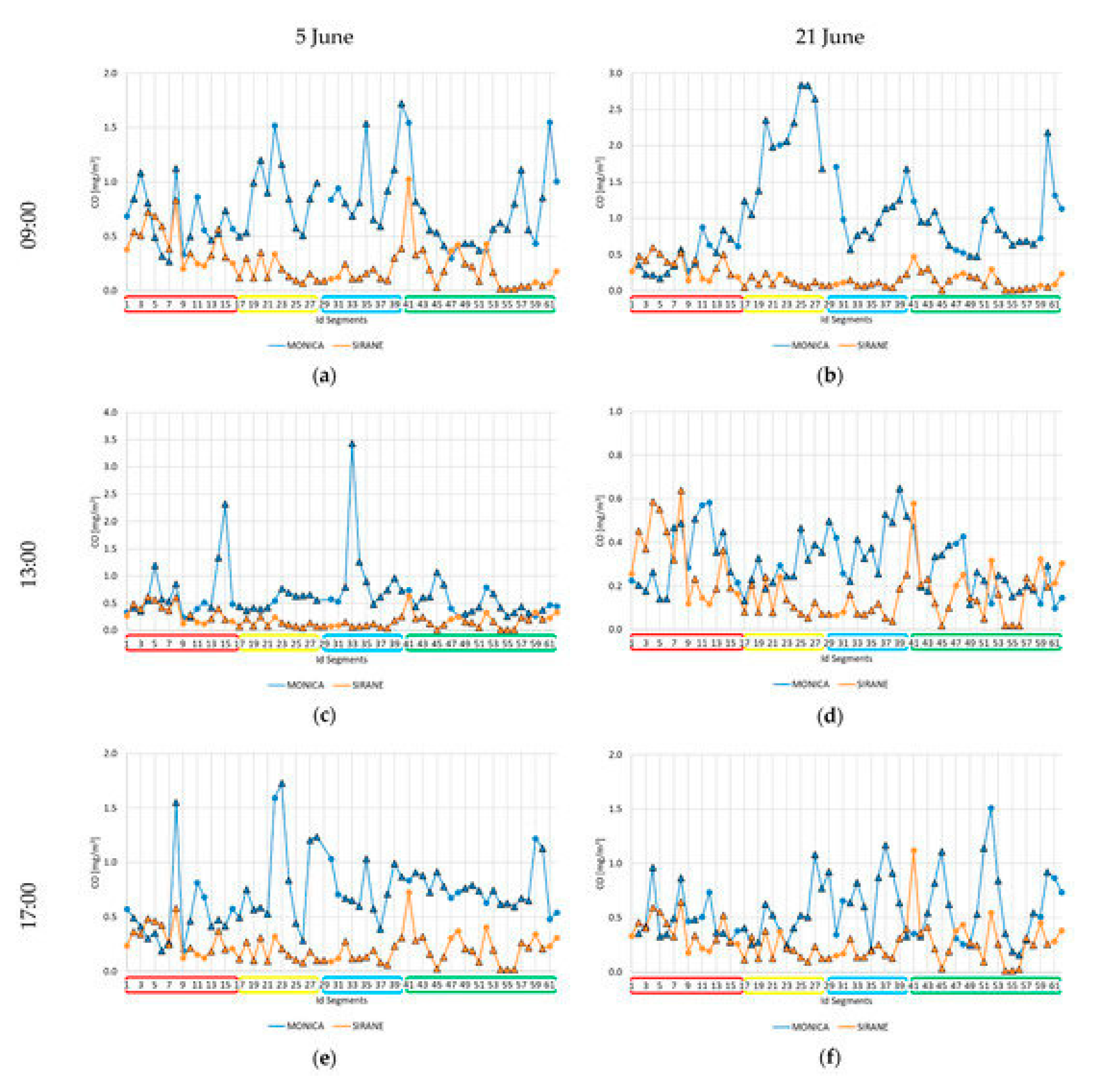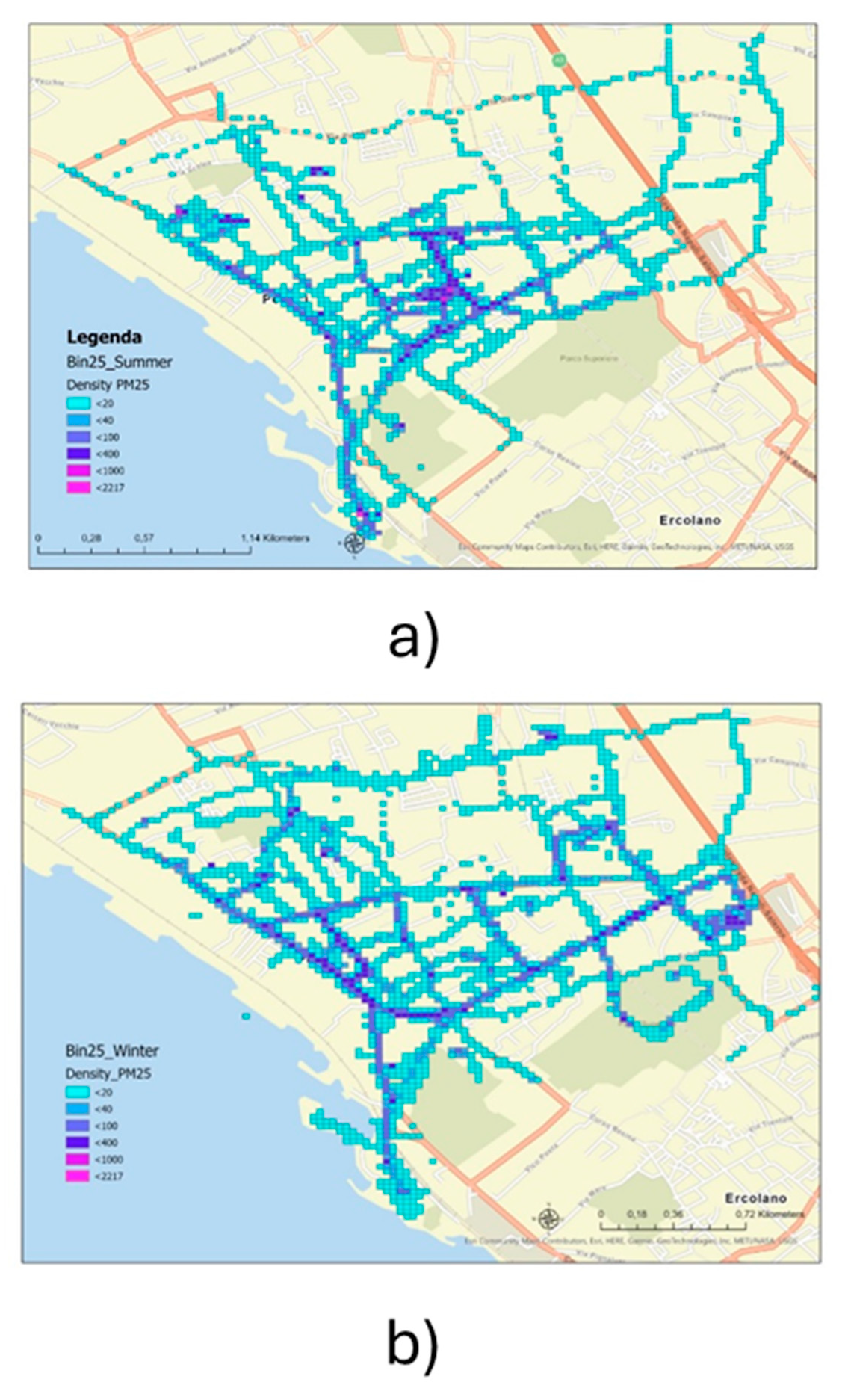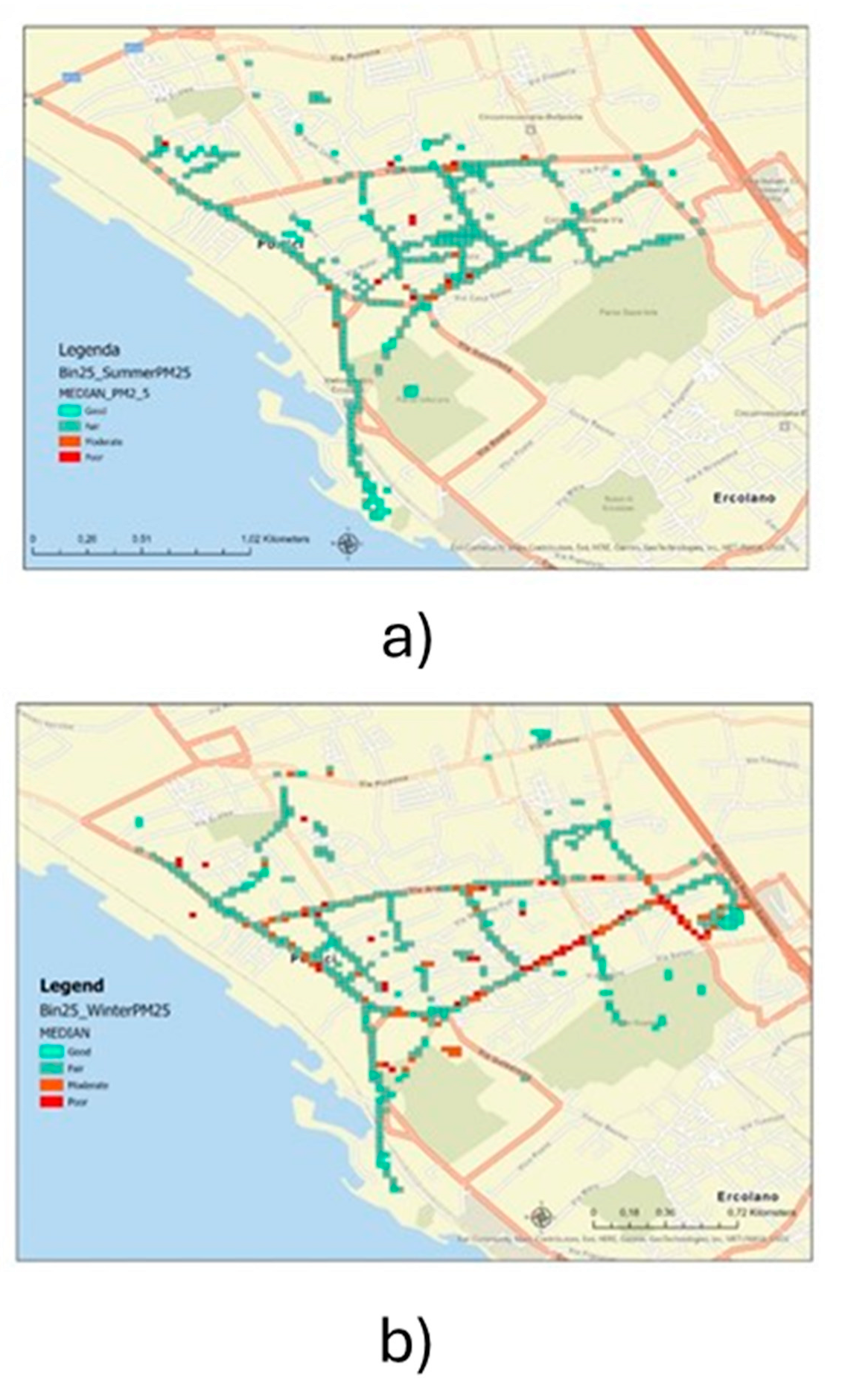1. Introduction
Last decades have seen the raise of awareness and concerns regarding the Air quality problem [
1]. Air quality concerns are particularly perceived in densely populated urban areas where they can significantly and largely impact public health by exposing them to harmful pollutants [
2,
3]. It is well known, actually, that their inhalation can cause several affections impacting respiratory organs (e.g. COPD, [
4]) , circulation (e.g. stroke) and cause development of cancer [
5]. In particular, NO2 short term exposure is known to be a cause of severe asthma while long term exposure is usually associated with several respiratory diseases [
6]. Ozone is instead well studied as irritant of the upper respiratory ways for short term exposures while there are evidences of long term effects in terms of accelerated decline in lung function and the progression of emphysema [
7]. Particulate matter depending on their size can be found in several tissues where it accumulates and can be source of continuous oxidative stress leading to ischemia [
8] and cancer [
9]. Hence, the increasing the pervasivity of accurate, factual knowledge about AQ concentration is a high valued goal. It can give political decision makers and citizens the ability of act based on scientifically validated data with positive impacts on quality of life, public health further reducing environmental inequalities.
One of the first driver of environmental inequalities is, actually, the scarcity of aq information in localized areas of cities [
10]. Pervasivity, however, is out of the operational envelope of the accurate but costly and bulky regulatory grade AQ analyzers causing a number of research resources to focus on low cost air quality monitor device development. During the last years, a significant number of funded research projects have been devoted to the development of technological and methodological strategies for Air quality pervasive and accurate monitoring (see OpenSense; Citi-Sense-MOB; Everyaware; Citi-Sense; “Schools for Better Air Quality” UNICEF Serbia pilot initiative, Breath London Network, [
11,
12,
13,
14,
15]). These complex projects face a number of difficult design choices trying to accommodate technological and social sciences opportunities and limits with their general requirements and goals. They could target pervasive monitoring, citizen engagement, AQ information augmentation, traffic or heating regulation, etc. or any combination of these. Of course these will inform and lead the solution choice. When accuracy is the main concern, for example, pinpointing the right sensing technology base is fundamental though it may conflict with financial resources [
16]. Dtata processing pipeline is fundamental to achieve the sought accuracy and calibration methodology choice is certainly at the core. Field calibration is the state of the art of LCAQMS calibration methodology but this choice can generate logistic issues when the deployment node is foreseen to exceed several tenths. UNICEF Serbia have recently started a pilot project with more than 120 deployed units [
14]. Acceptability and easy of use of sensor nodes will be paramount when citizen science is targeted [
17]. Eventually, preparing the citizen to correctly grasp the meaning of measurements is a difficult task needing adequate resources as well as communicating AQ data through universally understandable, accuracy informed and concise index without generating false expectations [
18,
19]. This of course depends on the cultural substrate, legal framework and expectation. If legal framework accounting is based on number of concentration thresholds overshoots than it could be easy to resort to this indicator. However, a common expectation is to use LCAQMS nodes to drive the local administration to act for remediation. Of course this is a false expectation since only regulatory grade monitoring device measurements are legally binding.
Most of the projects focused on fixed AQ network development but the development of portable AQ monitoring device is equally important for obtaining personal exposure insights. Low cost is a very important feature when aiming to personal monitors and is surely to be taken into account when targeting sustainable strategies for low income countries where highest concentrations for some pollutant can be recorded. Conversely, accuracy is the most sought feature when increase of regulatory grade network spatial coverage is the main goal.
A growing trend can also be observed for the number of devices currently involved in those projects aiming to involve a large number of the citizens. They could be either citizen scientists cooperating to the monitoring activities or observers participating in reviewing the results in seek for enhanced awareness and behavioural changes. In this framework our group observed the peculiarity of the Italian and European scenario while selecting common worldwide requirements. Usually, our urban settlments are mostly impacted by pollution generated by car traffic and household heating. The high density of historical features in city centers characterized by small spaces, the European legal framework and costs consideration prevented the development of pervasive air quality networks. As such we recognized the role of citizens awareness while keeping the momentum towards accurate measurements. For this reason we involved our partners in the development of the AirHeritage project. This has been a Urban Innovative Action project funded by EU under ERDF framework to be implemented in Portici, a small high population density city located 7km south of Naples in south Italy [
20]. Main aim was increasing spatial and temporal density information about most common air pollutants and simultaneously involving citizens associations in measurement process by deploying 30+ mobile devices thus increasing their knowledge on personal exposure, further densify the measurement process and increase their awareness. Aside from the measurement approach, a high resolution AQ forecasting model based on fluidynamic simulation, weather forecast data and measurement data assimilation developed by Terraria srl and Prof. Mazzoleni group from University of Naples have been deployed. Several informative and preparatory campaigns with citizens and schools have been conducted with the support of Legambiente Campania local associations and the factual involvement of local administration authorithies. This innovative, integrated, cooperative approach has strongly characterized the project ideation and development and ultimately guaranteed its technical and social success, while we have to recognize that a thoroughly effective pollution mitigation policy needs a continued and sustained in time approach. This work actually focus on sharing the lesson learnt on the technological side of the design and operation of a pervasive and accurate measurement approach culminating in the development of a hybrid network integrating fixed/mobile/regulatory grade analyzers. Next chapters focus respectively on the development of the AirHeritage version of the ENEA MONICA™ device, their lab based characterization and the development of a full-blown IT infrastructure for AH network data gathering, processing, storage and visualization. Furthermore, an efficient colocation strategy at the base of the adopted field calibration and validation approach is described. Eventually, the use of the gathered opportunistic measurements to generate ultra-high spatial resolution concentration maps is described completing the technological and sensors data processing pipeline. Each of the steps are completed by shorts and focused sentences highlighting the lessons learnt during the project implementation phase.
4. Comprehensive Software Platform Development
The Air-Heritage project had to handle different air quality data sources and provide many functionalities to the citizens, which required a careful design for the software platform to fulfill all the requirements. The air quality sensors, selected for deployment during AirHeritage project were of two different types, with different sampling and data transmission methodologies:
As above mentioned, the MONICA™ sensors were fully developed at ENEA Portici Research center. These devices are not equipped with wide area network connectivity and has no autonomous time clock reference. Consequently, as previously stated, data acquired from the devices must be sent via BLE to a device capable of transmitting the data to a remote server for centralized storage. The data must be augmented with a correct timestamp (in UTC format and synchronized with a time server). This device was either an Android smartphone using a dedicated App (for the mobility campaigns) or a custom sw equipped Raspberry Pi connected to wifi/cellular router.
Data generated from MONICA™ is actually sent using BLE to the WAN-enabled device in JSON format. Only raw, uncalibrated data is transmitted. This same format is used to send data using the HTTP protocol to the remote server. Raw data from MONICA devices is augmented with calibrated data. Only PM concentration values are available directly from the MONICA devices as expressed in µg/m3 (using Plantower sensors vendor calibration), and the calibration is done on the edge device (i.e., an Android smartphone, although the same is possible on the Raspberry Pi).
Data from the fixed stations used in the project, are sent via GPRS connectivity to an MQTT broker managed by the device supplier. The data is collected every minute and transmitted using the MQTT protocol every 15 minutes.
Data from the fixed stations comprise raw data as well as calibrated data. The initial calibration was provided by the device supplier using the default calibration from the sensor manufacturer. Later, after a co-location calibration, ENEA developed and compared multiple calibration methodologies, both statistical, such as Multiple Linear Regression (MLR) and AI-based (such as Random Forest, RF), significantly improving the provided measurements accuracy, especially using RF [
25,
26,
27,
28].
Almost all data involved in the project, with different time sampling, is essentially always time series data that could, theoretically, generate a huge amount of data and traffic towards the remote server responsible for storing all data in a centralized way.
Other requirements for the project were:
-
Provide a user interface, preferable web based, to allow clients to:
- ▪
Store and retrieve MONICA sessions, but only for registered users
- ▪
Report, in an interactive map, the status of the fixed stations with the AQI that should be updated, according to reglementary specifications, every 15 minutes (the time interval for an update form the MQTT broker)
- ▪
Download data as CSV format from fixed station or for specific session
Store data in a database in an effective way being able to keep good performances as time should passed by even in case of multiple devices and for long lasting MONICA sessions
Fulfill FAIR (Findability, Accessibility, Interoperability, and Reuse) requirements to allow easy access to data [
29].
Consider best practices in exposing services.
Address concerns about cybersecurity, including authentication and authorization.
4.1. Architecture of the Developed Software Platform
Taking into consideration all the above, after a deep analysis of the requirements and best practices involved in each field, the design phase resulted in the architecture depicted in
Figure 3 below.
As clearly reported in
Figure 3, air quality data is stored on a remote server using a REST (REpresentational State Transfer) API service [
30], through CRUD endpoints (Create, Read, Update, Delete) exposed by NGINX, a well-known reverse proxy server [
31]. Data is sent from the Android app/Raspberry Pi using the HTTP protocol in JSON format [
32]. The REST API service was developed using an opinionated web framework, ExpressJS, based on NodeJS [
33]. Some REST API endpoints, mainly that related to CRUD operations, were protected using Oauth2 authorization Protocol [
34]. This means that the generic client willing to use the described endpoints had to sign up for a valid account before being able to access these protected endpoints. For this task, the authors decided to use an external authentication and authorization service, Auth0, which offers both free and paid tiers [
35]. This approach made it possible to implement the following authentication mechanism:
- ▪
Social login as Facebook, Google, Twitter (now X)
- ▪
Account defined on Auth0 servers
This allowed to implement authentication and authorization in a simple and rapid way and support M2M (Machine to Machine) authentication for the Raspberry Pi devices [
36].
Data from fixed stations were inserted into the database by a NodeJS application acting as an MQTT subscriber. Every 15 minutes, a message with proprietary binary format was sent by the MQTT broker. Once correctly parsed, it was saved into a dedicated collection in MongoDB.
Initially, data from fixed stations included both raw and calibrated values for pollutants such as CO, NO2, and PM10, although the calibration reflected only the sensor manufacturer's indications. After an appropriate co-location procedure, calibration models developed by ENEA, particularly a Random Forest (RF) model, were deployed. The new calibrated values were computed using ad hoc JavaScript code executed on the server via NodeJS. By utilizing MongoDB's change-stream functionality a query automatically extracted inputs for the RF model and updated the collection with the newly calibrated values whenever new values were inserted into the respective collection [
37]. A similar procedure was used, via another JavaScript script, to compute the Air Quality Index (AQI) and update it every 15 minutes. The services executed on servers hosted at the ENEA Research Center constitute what are commonly known as backend services. The user interface, also known as the frontend, was developed using a JavaScript framework with associated functionalities (Vuetify as the UI library, VUE I18N for internationalization, etc.). The decision to develop the front-end application using Vue.js (version 2.x during the project's duration) was made due to its progressive performance and versatility in building web user interfaces. Other common alternatives include ReactJs or AngularJS. This choice enabled the development of a Single Page Application (SPA) for the project [
38].
Figure 4 shows the home page of the site available at
https://airheritage.portici.enea.it. Note the choice to proceed as a guest or a registered user; the latter option allows you to sign in or create an account using Auth0 services configured for the Air-Heritage Project. Authentication and authorization were handled by Auth0, and the user interface for signing in or creating an account was the same on both Android and web browsers (see
Figure 5).
The front-end reported general information about the project and allowed users to view logged users' registered MONICA sessions. It also displayed real-time data from fixed stations in terms of AQI (Air Quality Index) on an interactive map (created using LeafletJS), with updates every 15 minutes [
39,
40].
Figure 6 and
Figure 7 provide examples of the UI built for the project related to the two main features described earlier.
4.2. Data Management and Associated Monitoring Services
As already stated, data, mainly of the time series type, must be centrally stored. For this, a NoSQL-based solution was chosen: MongoDB Community Edition. This type of database, when using a proper schema for time series data, is well-suited for data coming from IoT devices. Moreover, horizontal scaling features like replica sets and sharding provide the necessary capabilities for a scalable and fault-tolerant solution, with authentication and authorization features available at the collection level. The following base collections were saved in MongoDB:
MONICA sessions raw data
MONICA sessions calibrated data
Fixed stations raw data, factory calibrated data and calibrated data using RF
Derived stats for all the above collections, populated automatically thanks to change streams feature of MongoDB
AQI data derived from data at point 4, thanks to change streams feature and a JS code (executed in NodeJS) to compute the AQI index (with color reference)
Stats data by user for the citizen pricing campaign, even this computed using a JS app reacting to events generated by MongoDB change streams
The choice to separate data into different collections was driven by the expected query patterns. The data schema was of the bucket type, with daily or session-based grouping in accordance with MongoDB best practices [
41].
As described previously, the entire software solution is made up of many JS applications. Because both the front-end and the back-end use JS as their core, it constitutes what is known as a full-stack JS solution. These applications are monitored using PM2, a commonly used process manager that monitors all the JS applications and restarts them in case of failures. To be notified in case of unhandled exceptions, Sentry [
42] (a cloud service for remote error monitoring) was used for both the front-end app (VUE SPA) and the back-end services. Similarly, Uptrends (a website availability monitoring service) was used to monitor the general availability of the web server. The software solution also sees the use of Failban [
43] to monitor the NGINX logs and react automatically to handle anomalous traffic towards the server hosting the REST API and the SPA.
4.3. Lessons Learned from Software Integration and Utilization
The software solution/platform developed for Air-Heritage was able to effectively handle the IoT device data from both MONICA and fixed stations, with some real-time functionalities thanks to the change-stream feature available in MongoDB for the replica-set configuration. Nonetheless, some elements could be improved, and although every solution has its pros and cons, the main findings from the experience gathered by the authors can be synthetically summarized below:
- ▪
The JSON serialization format could effectively be replaced by Protobuf for transmitting data from the Android/Raspberry Pi device to the cloud/remote server. This change could allow for more efficient data transmission, as Protobuf messages are much smaller in size compared to JSON (from 20% to 80% smaller than equivalent JSON messages) and this reduce system latency [
44].
- ▪
MQTT is definitely the preferred protocol at OSI layer 4 to use instead of HTTP [
45].
- ▪
MongoDB was a valid and effective solution. However, current versions of MongoDB (especially starting from v.7 and later) implement TS collections that simplify code development while automatically handling IoT data in an efficient way. Sadly, this introduces some limitations, such as lack of support for change streams widely used within the project, document size (4MB compared to the generic MongoDB document limit of 16MB), and more [
46]. These limitations, hopefully, will be removed in future versions of MongoDB. For data coming from IoT devices, other solutions more tailored to TS data could be preferable, such as TimeScaleDB, InfluxDB, QuestDB, to name a few.
- ▪
The REST API framework used within the project could be replaced with a solution based on a different language, such as Fiber for Go or FASTAPI in Python. However, a Node.js-based solution is still, in the author's opinion, a valid choice
- ▪
To further improve scalability and fault tolerance, it could be useful to revisit the entire solution by employing Kubernetes, with all services deployed using Docker containers and adopting CI/CD practices [
47].
- ▪
Although the FAIR principles were fulfilled as much as possible, adding an ontology to the data stored in MongoDBcould certainly be a very attractive option [
48].
5. Effective Logistics Management for Co-Location Campaigns
5.1. Lessons Learned from Software Integration and Utilization
The co-location of sensor nodes with a duly certified reference instrumentations is a prerequisite for progressing to the succeeding phase of node calibration by means of machine learning techniques [
49]. It also convey significant information for characterizing sensor response in real world scenarios. The aforementioned step of the Air Heritage project saw a fleet of 30 MONICAs undergo three separate co-location periods in three distinct geographical areas of the Portici city. A mobile regulatory grade analyzer truck by ARPAC (Campania Environmental Protection Agency) was used as reference station in all co-location campaign while the characteristics of the reference air pollution analysers parameters are reported in
Table 1.
The first co-location took place on 2021-01-13 at Portici WaterFront until 2021-03-24, the second co-location period start on 2021-07-04 at Isola Ecologica in Portici up to 2021-10-04 but with some long suspension period due to temporary unavailability of the mobile laboratory. Further details are given in metadata file associated to the publicly available Air-Heritage datalake (see Data Availability Statement paragraph) . Finally, the third co-location took place instead in Scuola Da Vinci Comes in Portici on 2022-01-11 until 2022-04-13.
The co-location campaigns occurred concurrently with the spread of the COVID-19 and the introduction of legislative constraints in Italy due to the state of emergency. These restrictions effectively constrained the operations of the staff in the assembly and maintenance phases of the entire campaign of co-locations.
5.2. Logistical Challenges and Implemented Solutions
Whether to co-locate all 30 units simultaneously or to divide them into groups for successive periods was one of the first concerns to be addressed. The latter option was selected for two fundamental reasons:
The placement of the particulate matter instrumentation and other equipment’s of the institutional-grade mobile laboratory has resulted in a reduction of the available space on the roof of the vehicle, which has in turn constrained the capacity to accommodate the entire fleet of nodes.
In order to prevent data loss and collisions between packets during transmission, a maximum of 10 nodes were connected to a single Raspberry Pi, which was employed as a concentrator node for aggregating and forwarding raw data from the nodes to the web server.
In order to guarantee an adequate quantity of data for the training phase, a minimum of three weeks of co-location is required for each individual batch.
Despite the MONICA device's internal rechargeable battery, which is exerted for use in mobile sessions, when colocated it is powered by a 10-Port USB hub when arranged in a fixed configuration. This is due to the fact that the device draws its power supply from the mobile laboratory's main power distribution.
Figure 8 illustrates the position of the co-location campaigns on the map and provides a detailed account of the assembly phases.
The MONICA raw sensors data are captured and transmitted via Bluetooth Low Energy (BLE) to a Raspberry Pi Mod. 3B+ based datasink with Raspbian OS providing for WAN connectivity services through a mobile router wi-fi TP-Link M7650. Data acquisition is managed by a Python script running on the Raspberry Pi. At remote side, an ad-hoc IoT backend architecture relying on a contained NodeJS REST APIs server and MongoDB provides data inception, device management, storage and data pre-processing (see
Figure 9).
The integration of a Wi-Fi router into the IoT infrastructure design provides the additional benefit of enabling remote control of data transmission. This is achieved by accessing the Raspberry Pi as a remote desktop with the RealVNC® application. This enables the remote monitoring of data transmission, allowing for the assessment of device functionality and the identification of instances of non-transmission. In the event that on-site verification is required, it can be scheduled. It is crucial to acknowledge that any issues with the reference mobile vehicle power supply may impact on the entire network of the co-located devices. In the event of a power shortage, the internal battery of the Wi-Fi router will be discharged, thereby rendering remote access impossible.
During the second co-location campaign, which spanned from 2021 July 4th to 2021 October 4th at Isola Ecologica, the unavailability of the ARPAC mobile regulatory-grade truck, due to emergency relocation, necessitated the co-location of a number of nodes exceeding 10. This was done in order to expedite the process in anticipation of future Citizen Science campaigns. In this particular situation, we elected to utilise two Raspberry Pi, apportioning half of the nodes to each individual Raspberry.
The latter highlights the importance and the difficulties related to the access to reference stations which, in our case, was made possible thanks to the collaborative efforts of ARPAC. Direct access may also be impossible in several settings due to the unavailability of locally deployed reference stations or the lack of resources needed to guarantee this access for research personnel to the regulatory grade stations. It is worth to remember, that these, in turn, are designed and operated for different goals and implement strict regulatory framework to keep being source of authoritative data for the community.
5.3. Recommendations for Future Co-Location Efforts
The IoT infrastructure adopted solution has been demonstrated to be an effective and dependable approach for managing the data load of a subset of ten nodes. It is evident that the solution utilising Raspberry Pi is a cost-effective and open-source option, particularly when combined with Python scripts.
Any effort should be made to allow for closeby co-location between all nodes and the reference analyzers. In case of a high number of LCAQMS with significant dimensions this may represent an issue but accurate colocation planning after a site inspection may allow for optimal trade off (see
Figure 10).
The decision to divide the fleet into three batches per co-location was largely a practical necessity in our case. However, the management of a limited number of devices has proven to be an effective approach. This method allows for the periodic remote monitoring of node transmission status, which is a valuable tool for maintaining operational efficiency. Currently, this activity is performed manually and on a periodic basis. It is recommended that this process be automated in the future by developing a series of Python scripts that monitor the data transmission status and send an alert in the event of prolonged lack of received data packets. Such an approach would facilitate timely intervention to resolve the problem, which could be of an electrical nature, a lack of power supply, or a variety of issues specific to the individual node. Furthermore, the management of a limited number of co-located nodes offers the additional benefit of facilitating maintenance activities.
Finally, we have attempted to utilise batching in order to assess the efficacy of novel calibration methodologies, including global calibration [
50]. This methodology was developed with the specific objective of reducing co-location and calibration costs through the utilisation of a virtual calibration model that incorporates the inherent variability of individual sensors. The findings indicate that co-locating a minimum of five nodes is sufficient to apply the virtual model to the remaining nodes for low-cost particulate matter sensors [
51]. This approach is undoubtedly beneficial in the context of large-scale deployments. Further research is required to validate this approach on large deployments and to ascertain whether an extension to gas sensors is also feasible [
52].
6. Calibration and Data Management
Most Low cost Air Quality sensors needs a calibration law which translate their raw response values, usually encoded in electrical variables, in actual concentration data. Typical example are MOX which encode concentrations in resistivity or Electrochemical sensors which encode concentrations in electrical potentials, or QMB which response are encoded in frequency shifts [
53]. Unfortunately, along with their undoubted advantages, they suffer from several operational issue which hinder calibrated values accuracy, these effects are particularly significant when field deployed. Among these, fabrication variance, which imply sensing unit characteristics variance, lack of stability, which make these characteristics to vary in time, environmental and non target gases sensitivity which make their response vary with those factors intensities, are the most challenging. Their combined effect requires extensive and/or frequent recalibration actions in time or after relocation [
54,
55,
56]. These considerations pointed us to proceed to develop a peculiar though literature based, calibration strategy so to keep a balance between due efforts and accuracy with the latter as a priority. These, together with devices batch size, availability for actual deployments, and the need for reference data constituted the operational and functional requirements which lead us to devise a seasonal recalibration protocol exploiting field calibration as the preferred and most accurate methodology [
57]. Whenever available, colocation data provide in facts for the best reference data to achieve a data driven calibration.
According to the plan described in previous chapter and detailed in
Table 2, all fixed and mobile devices have been collocated with a reference analyzer at least for three weeks in three different seasons and locations within the city of Portici, the target city of the Project. Actual operative deployment occurred between 2 consecutive calibration periods.
Figure 11,
Figure 12 and
Figure 13 actually shows some of the operative deployment preparation phase including pre-charging for mobile devices and the deployment of one of the fixed units. All raw data recorded during the colocation periods have been captured along with reference analyzers readings provided by regulatory grade mobile monitoring station. Time reconciliated data series have been collected in an ad-hoc datalake comprising both fixed stations and mobile stations colocation data in order to support the selection, development and test of calibration algorithms.
Generally, AQ multisensory calibration algorithms use raw sensors data together with environmental variables, so to correct their interferences and return concentration estimations as an output. Formally, let
the true concentrations vector and
the input raw sensors readings matrix, calibration stage aims to derive a function
, such that,
with
being the residual calibration error.
As we have seen before, raw gas sensors data encodes forcers information as analog voltages, frequency shifts, or IR spectras, whilst PM sensors either use particle count as raw data or provide a vendor based calibrated output which can be used as “raw” input data. As we introduced above, response forcers may include target gas and other gaseous interferents as well as environmental interferents. X vector may turn in a matrix if including past records of the same variables and/or past target concentrations as stored in tapped delay lines (lagged values) for deriving dynamic and/or recurrent models, respectively. In our case, the input variable array X included raw data from the chosen electrochemical sensors (working and auxiliary electrode voltage) for target gas and interferents, plus environmental interferents. For NO2, this is expressed as:
where
(in mV) and
(in mV) are the output of Working and Auxiliary Electrode, respectively, of NO2 sensor, T is the Temperature (in °C). In facts temperature is reported as one of the most significant interferents for electrochemical gas sensors. Alphasense itself advised to correct concentration estimations according to temperature values.
For CO gas concentration estimation, we used CO sensors WE and AE voltages, plus temperature readings. Hence, X is instead given by:
Due to well known interference of NO2 concentrations on the chosen sensors, O3 concentration was estimated using sensor readings coming from NO2 and O3 sensors plus temperature readings:
Conversely, Humidity served as primary correction factor in the MLR model formulation for PM sensors, for the MONCIA devices we hence had:
Note that vendor estimated size fractioned concentration for the targeted pollutant was used as raw sensor for PMS7003 sensors calibration along with Relative Humidity readings.
According to literature and to our field deployments experience, 3 weeks colocation data are sufficient to obtain optimal short term accuracy performances [
56,
58]. Regarding the model choice, multilinear regression is actually providing a good balance between short term precision and accuracy metrics while showing interesting generalization properties for mid term deployments [
59]. Comparatively, Random Forest model among non linear machine learning approaches is usually referred as providing best accuracy for short term deployment but fail to provide accurate concentrations readings when operating outside the input ranges within which it has been trained. MLR has been hence been chosen as a data driven model for providing calibration for both Gas and Particulate sensors for mobile and fixed stations according to
where b is the intercept and a are the least square optimal coefficients.
Summarizing, to ensure the highest accuracy during long-term deployment, the AirHeritage project has implemented an edge computing, field calibration, data-driven, MLR model based calibration scheme for 30 mobile analyzers, with periodical season based recalibration. Accuracy figures estimations for the MONICA devices, obtained with 2 consecutive weeks long calibration set during period 1, are reported
Table 3: Crossvalidated MLR performance metrics averaged for the 30 MONICA devices (2 Consecutive Weeks Training length, 1 Week Test Length, 2 temporal stratifications over 3 weeks) during the first colocation period. Negative estimations are reverted to null concentrations. It is important to stress the importance to estimate performance using consecutive temporally stratified training and test set, avoiding any data leaks so to simulate real deployment conditions thus obtaining realistic performance indexes estimations. In terms of coefficient of determination, depending on the pollutant specie we obtained values which span from 0.43 of PM10 estimations to 0.88 for Ozone concentration estimations. Low values obtained for PM10 can be explained with the low sensitivity of the specific sensor to that size particulate fraction as it is well known that most of low cost particulate sensors are optically tuned to express maximum sensitivity to PM
2.5 fraction. Performance of CO sensor are explained with the low concentrations recorded during the specific colocation period (see
Figure 14 and
Figure 15).
The analysis of performance variance showed that in this short term deployments, with the exception of short term transients, we did not record performance extremes with all devices showing consistent performance ratings (see
Table 3). Just as an example, R
2 ratings showed a minimum value of 0.72 and a maximum value of 0.93. Since actual concentration range is a significant factor influencing performances we also report that MAPE readings was comprised between a minimum of 4.4% and a maximum of 9.4%, in the latter case the device kept an R
2 of 0.78.
Unfortunately, our multiseasonal recordings confirmed that ab-initio field calibration performances show a significant performance drop which requires re-calibration at least on a seasonal basis, which we actually performed. As an example R
2 figures for PM2.5 dropped to an average 0.26, as we reported in [
58].
We remind that calibration function was actually executed on a smartphone, enabling immediate and localized feedback to the user while they move across the city which resulted in a really appreciated feature. For doing so, we decided to temporarily store Calibration parameters in the Android app resource files, where they are retrieved at the start of each recording session. This allows for updates without needing to rewrite the device firmware and the need for stable connectivity. However, as cellular connectivity has reached an operational maturity allowing for stable connection almost everywhere, we chose, for the next version of the MONICA ecosystem, to provide an upgrade to store calibration parameters on centralized inception and storage facilities, eliminating the need for app updates. This will also make easer to constantly upgrade calibration parameters if remote calibration strategy will be in place.
Three weeks colocation duration showed appropriate to build a sufficient dataset covering the intra-seasonal concentrations and environmental conditions variance, thus allowing for optimal short term performances [
57].
Periodic Field calibration by colocation quickly become unfeasible for the number of devices usually involved in recent projects / commercial deployments which is approaching several tenths or hundreds of nodes [
14] while could be still effective for accuracy driven short term experimental deployments [
59,
60]. Repeated removal and deployments procedures, represents the main cost sources along with the costly access to reference colocation data. They also represent a significant risk for multisensory devices damage.
The use of universal calibration [
50] or calibration transfer approaches have been explored as a way to reduce calibration efforts limiting the number of devices to be recalibrates. However, apart from PM sensors which show a limited fabrication variance, our results for electrochemical or MOX gas sensors are still controversial. Eventually if sensors drift kicks in then the accuracy of all calibration methods and models will fade without upgrades.
Remote calibration or periodic in place colocation with gold nodes can provide reference data for reducing drift impacts [
61]. Solution has to be chosen according to different parameters including the availability of close enough or correlated/statistically reconciliable source of data in case of remote calibration and or logistic burden for gold nodes opportunistic or routine recalibration [
62].
Dynamic calibration with recurrent architectures (say RNNs) could be needed to limit the impact of sensor response time on pollution mapping while on the move. In our case the limited speed of pedestrian citizen which represented the backbone of AirHeritage citizen sciences campaigns and the sensors T90 values (<1min) made us confident to resort to static calibration.
Since local, real time, assessment of pollutant exposure meet the citizens favour, we advise for inclusion of such a feature in any portable device. As such the local availability of the calibration model will be important to guarantee this function in real time without resorting to cloud and avoiding the relative costs. Thanks to general availability of cellulare WAN connectivity, we advise to download model updates at each measurement session start.
Average Sample loss rate (hours) < 15%
Accuracy performance metrics estimations reported median MAPE of less than 10% for all pollutants while coefficient of determination varied from 0.43 fro PM10 to 0.88 for Ozone.
Figure 16.
Distribution, across the 30 Monica devices, of R2 (first coloumn) and MAE (second coloumn) short term performance values for NO2 (first row), O3 (second row) and CO (third row) as estimated by MLR based data driven calibration in deployment period 1.The distributions appear to be skewed by a few outliers. Performed checks show anomalus low performance are due to transients in raw sensor responses when they were first switched on.
Figure 16.
Distribution, across the 30 Monica devices, of R2 (first coloumn) and MAE (second coloumn) short term performance values for NO2 (first row), O3 (second row) and CO (third row) as estimated by MLR based data driven calibration in deployment period 1.The distributions appear to be skewed by a few outliers. Performed checks show anomalus low performance are due to transients in raw sensor responses when they were first switched on.
Figure 17.
MAE (1st coloumn) and R2 (2nd coloumn) and short term performance for PM2.5 (first row) and PM10 (second row) as estimated by MLR based data driven calibration in deployment period 1 , across the 30 Monica devices.
Figure 17.
MAE (1st coloumn) and R2 (2nd coloumn) and short term performance for PM2.5 (first row) and PM10 (second row) as estimated by MLR based data driven calibration in deployment period 1 , across the 30 Monica devices.
8. Impact of Spatial Analysis of Citizen-Generated Data
Capturing the local variability in air pollutant concentrations within the cities is a key issue to assess the urban air quality at high spatial resolution as well as to evaluate the citizen exposure to high air pollution levels [
10]. To address this issue within the project, a pervasive urban air quality monitoring using hybrid deployments of sensor networks has been investigated.
As shown in literature, the high spatial variability of urban air pollution is not usually captured by regulatory monitoring networks being sparsely distributed within the city. As first task, the deployment of fixed low-cost sensors networks has been designed and developed across the pilot City of Portici.
Using networks of stationary low costs sensors within a city, neighborhood-level differences as well as near specific sources (e.g., roadways) can be captured and pollutant spatial variations at fine (sub-km) length scales can be quantified. At this scope, the relevant question of the “optimal sampling design” has been investigated. Thus, optimal sites for deploying stationary low-cost sensors have been identified aimed at a spatially dense air pollution monitoring on the basis of which more reliable air quality forecasts across the city can be obtained as well as population pollutant exposures can be evaluated more accurately.
To do that, a spatial multicriteria analysis (GIS-Multi-Criteria Decision Assessment) has been developed for selecting suitable sites for low-cost multi-sensor traffic-orientated stations across the city [
63].
The street canyon effects and the traffic-related emissions were selected as suitability criteria intending to represent the impact of local sources and land use on measured pollutant concentrations. In fact, street canyon effects, generated by the ratio between the buildings height and the streets width, can modify concentration patterns near roadways. The traffic-related emissions contribute to background pollutant concentrations but they are also the principal source of local variation in the concentrations of urban air pollutants. Higher pollutant concentrations are in high traffic emissions areas.
High- and low- traffic emission zones and hybrid zones were identified by a spatial hot spot analysis. All selected criteria were performed as geographical variables and combined in a weighted spatial overlay. For the pilot city of Portici, a map of suitable sites was generated for deploying low-cost multi-sensor traffic-orientated stations for monitoring NOx and PM2.5 concentrations and quantifying their spatial variability until urban streets (
Figure 22).
Among the main results of this approach, we can list:
Low-cost monitoring stations located at the eligible sites so identified can convey information on areas on which space variability is significant, providing that informative content which is actually lacking for both regulatory monitoring networks and modelling based approaches for air quality mapping.
In addition to the local spatial variability, the temporal variability of air pollutant concentrations has to be taken into account for obtaining more reliable urban air quality scenarios.
One of the possible limitations to the use of the proposed spatial analysis is its reliance on data. Data could be difficult to obtain such as vehicular flow (simulated or measured) as well as the street canyon effects. In these cases, the use of proxy data could partially solve the issue.
Also, air quality data gathered by stationary low-cost (multi-) sensor networks as well as mobile and opportunistic monitoring campaigns across urban areas can be fundamental in data assimilation approaches aimed at including the variability patterns of air pollutant concentrations that conventional chemical transport models or land use regression models fail to adequately represent.
In that regard, we have investigated the capability of an operational air dispersion model at district scale, such as SIRANE in identifying the local spatio-temporal variability of pollutant concentrations within an urban district, with respect to mobile monitoring campaigns, using the low-cost sensor devices – MONICA [
64,
65]. The campaign consisted of 6 runs, along a fixed monitoring route, repeated at two different days and different times on one day (
Figure 23). By comparing the mean concentrations of CO and NO2 pollutants measured by MONICA devices and those simulated by SIRANE along the urban streets, we have shown that the recorded concentrations appear exceeding the simulated ones by a factor of 3 and 2 for CO and for NO2, respectively. Furthermore, for both the pollutants, this factor is higher within the street canyons than in open roads. However, the data recorded and the simulated pollutant concentrations show patterns that broadly correspond, and also the peaks observed in the mobile profiles appear in the simulated profiles, though smoothed (
Figure 24). The outcomes highlighted that there are differences between measured and estimated pollutant concentrations due to several factors. The operational conditions are one of these. MONICA measures pollutants concentrations at about 1 m height and at high temporal resolution, capturing also concentration peaks due to events that occurred during the monitoring run such as a closely passing car or bus, or walking in the emission plume right behind a vehicle, or even idling vehicles due to local traffic congestion. SIRANE evaluates hourly concentrations, spatially averaged in each street segment.
The further task was to explore the potential of participatory monitoring campaigns for mapping the exposure to air pollution in the urban environment at a high spatial resolution. This monitoring approach made use of citizens’ common daily routines to move low-cost air quality measurement devices as MONICA around the city. It is a promising approach based on un-structured setup to collect large datasets that give useful additional information at a reasonable cost compared to classical data collection methods. But, depending on the set-up of the data collection, such new data can lead to new challenges in data processing and interpretation. At this regard, a statistical analysis method as spatial binning was applied in an original way for exploring the distribution of the large dataset collected by the citizens carrying MONICA devices during their daily walking routes around the city results in unstructured measurements without distinct patterns in space or time.
The collected measurements were grouped in a summer (from April to July) campaign and a winter (from October to December) campaign on most of urban roads. About 46.000 raw 5 s measurements of CO, NO2, O3, PM2.5 e PM10 concentrations were recorded during the summer campaign and about 100.000 raw 5 s measurements of the same pollutants during the winter campaign. Most of the measurements were done between 8 a.m. and 5 p.m. during working days. The study area covers approximately 4 km2.
For distribution analysis of these opportunistic measurements, the data were spatially aggregated within bins of 25x25m, located along the street networks and statistic of median were calculated. To assure data quality, the calculated median was based on at least 20 measurements. Maps of measurements density for each bins and for each recoded pollutant were performed (
Figure 26). Similarly, maps of the distribution (median value) of the recorded pollutant concentrations within the 25m-bins were performed (
Figure 27) and categorized as good, fair, moderate, poor. Most of pollutants concentration measurements fall in the moderate and poor classes in winter campaign, while in the summer campaign they fall mainly in good and fair classes.
8.1. Potential Improvements for Future Geostatistical Studies
Factors that can impact on the sites eligibility for low-cost multi-sensor monitors could be considered such as the shadow effect of buildings and trees as well as the evaluation of minimum winter solar radiation value to be ensured, as further location constraints. In fact, low-cost monitors are generally equipped with a photovoltaic panel and a battery storage and installed on existing street lighting poles. Including these constraints should allow to select sites with a better sun exposure over the year. Furthermore, the use of MONICA devices at different heights as well as opportunistic and more pervasive monitoring campaigns could improve understanding of the differences between measured and modelled concentrations. Thus, a limited number of measurements and sampling errors impact the uncertainty of concentration level distributions although large spatial patterns within the city are also captured. The deployment of unstructured opportunistic mobile monitoring, coupled with repeated measurements and a meticulous approach to data processing and interpretation, is of paramount importance. This monitoring strategy must be capable of collecting a substantial amount of data, encompassing both spatial and temporal variability across the city. Until low-cost air quality sensors are developed that can collect data of sufficient quality in an effortless manner, it is imperative to maintain motivation and follow-up with participants.
Author Contributions
Conceptualization, S.DV, G.D.; methodology: all Authors.; software, S.F., G.D,, S.DV; validation, E.E., S.F., G.D.; investigation, all authors; data curation, S.F., E.E., G.D., S.DV.; writing—original draft preparation, S.F.,G.D.,S.DV, F.F., E.E., G. F.; writing—review and editing, S.DV.; visualization, S.F.,G.F., S.DV; supervision, S.DV., G.F.; project administration, G.DF; funding acquisition, S.DV., G.DF. All authors have read and agreed to the published version of the manuscript.
Figure 1.
MONICA(TM) node diagram.
Figure 1.
MONICA(TM) node diagram.
Figure 2.
Front and back picture of the MONICA node.
Figure 2.
Front and back picture of the MONICA node.
Figure 3.
Synthetic schema complete software architecture Air Heritage Project.
Figure 3.
Synthetic schema complete software architecture Air Heritage Project.
Figure 4.
Air Heritage home page.
Figure 4.
Air Heritage home page.
Figure 5.
Sign in/up provided using Auth0 service.
Figure 5.
Sign in/up provided using Auth0 service.
Figure 6.
Status of Air quality from fixed stations.
Figure 6.
Status of Air quality from fixed stations.
Figure 7.
Interactiva map for a MONICA registered session.
Figure 7.
Interactiva map for a MONICA registered session.
Figure 8.
The position of the three co-location campaigns on map performed in Air-Heritage Project and a detail of of the assembly.
Figure 8.
The position of the three co-location campaigns on map performed in Air-Heritage Project and a detail of of the assembly.
Figure 9.
Scheme of IoT architecture in stationary setup.
Figure 9.
Scheme of IoT architecture in stationary setup.
Figure 10.
The 7 fixed stations as deployed nearby the reference mobile station during calibration data gathering (colocation periods).
Figure 10.
The 7 fixed stations as deployed nearby the reference mobile station during calibration data gathering (colocation periods).
Figure 11.
MONICA devices as ready to be shipped to citizens.
Figure 11.
MONICA devices as ready to be shipped to citizens.
Figure 12.
Precharging MONICA devices.
Figure 12.
Precharging MONICA devices.
Figure 13.
Actual deployment of AirHeritage fixed stations.
Figure 13.
Actual deployment of AirHeritage fixed stations.
Figure 14.
Lognormal fitted pollutant concentrations as recorded in the first colocation period.
Figure 14.
Lognormal fitted pollutant concentrations as recorded in the first colocation period.
Figure 15.
Lognormal fitted concentrations of CO as recorded during the first colocation period.
Figure 15.
Lognormal fitted concentrations of CO as recorded during the first colocation period.
Figure 18.
The web page of the IoT Platform for downloading the MONICA app .apk file.
Figure 18.
The web page of the IoT Platform for downloading the MONICA app .apk file.
Figure 19.
(a) An illustrative example of a user session as displayed on the webpage, accompanied by an indication of the location and the level of pollutants. (b) An illustrative example of a user session as displayed on the MONICA app.
Figure 19.
(a) An illustrative example of a user session as displayed on the webpage, accompanied by an indication of the location and the level of pollutants. (b) An illustrative example of a user session as displayed on the MONICA app.
Figure 20.
A schematic representation of the data flow in a mobile application scenario.
Figure 20.
A schematic representation of the data flow in a mobile application scenario.
Figure 21.
The workflow performed in the Air-Heritage project.
Figure 21.
The workflow performed in the Air-Heritage project.
Figure 22.
Site suitability map for networks of low-cost traffic-orientated stations for air pollutants monitoring across the city of Portici.
Figure 22.
Site suitability map for networks of low-cost traffic-orientated stations for air pollutants monitoring across the city of Portici.
Figure 23.
A view of the optimal location (evaluated highly suitable) of Piazza San Ciro (City of Portici) for the NOx and PM2.5 sensors to be installed across the city.
Figure 23.
A view of the optimal location (evaluated highly suitable) of Piazza San Ciro (City of Portici) for the NOx and PM2.5 sensors to be installed across the city.
Figure 24.
Maps of the mobile monitoring campaigns along the selected monitoring route.
Figure 24.
Maps of the mobile monitoring campaigns along the selected monitoring route.
Figure 25.
Comparison between MONICA (blue line) and SIRANE (orange line), for CO pollutant on 5 June. Triangles are street canyons and circle open roads. The ID receptors are grouped by monitoring road segments.
Figure 25.
Comparison between MONICA (blue line) and SIRANE (orange line), for CO pollutant on 5 June. Triangles are street canyons and circle open roads. The ID receptors are grouped by monitoring road segments.
Figure 26.
Maps of the PM2.5 measurements density for each 25m-bin in summer a) and winter campaigns b).
Figure 26.
Maps of the PM2.5 measurements density for each 25m-bin in summer a) and winter campaigns b).
Figure 27.
Maps of the distribution (median value) of the recorded PM2.5 concentrations within the 25m-bins in summer a) and winter campaigns b).
Figure 27.
Maps of the distribution (median value) of the recorded PM2.5 concentrations within the 25m-bins in summer a) and winter campaigns b).
Table 1.
Instrumentation used on board the reference mobile laboratory.
Table 1.
Instrumentation used on board the reference mobile laboratory.
| Parameters |
Technology |
Type |
Units |
| NOX |
Chemiluminescence |
Thermo Scientific Mod. 42i |
µg/m3
|
| CO |
Non-dispersive infrared spectroscopy |
Teledyne API Mod. T300 |
mg/m3
|
| O3
|
Ultraviolet photometry |
Teledyne API Mod. T400 |
µg/m3
|
| PM10/PM2.5 |
Beta-ray attenuation |
FAI Mod. SWAM 5a Dual Channel Monitor |
µg/m3
|
Table 2.
Colocation scheme of the mobile MONICA devices. The schema encompasses 3 Periods in 3 different seasons and locations within the urban area of Portici (Naples).
Table 2.
Colocation scheme of the mobile MONICA devices. The schema encompasses 3 Periods in 3 different seasons and locations within the urban area of Portici (Naples).
| |
Period 1 (2021) |
Period 2 (2021) |
Period 3 (2022) |
| # |
Batch 1 |
Batch 2 |
Batch 3 |
Batch 1 |
Batch 2 |
Batch 3 |
Batch 1 |
Batch 2 |
Batch 3 |
| |
Jan, 13th 15:00 -> Feb, 5 12:00; |
Feb, 5th12:00-> Mar 2nd, 10:00 |
Mar, 2nd 14:00 -> Mar 24th 10:00 |
Jul, 4th 00:00 -> Jul 19th 23:59; |
Aug, 24th 11:00 >Sep,14th8:40; |
Sep14th1015 -> Oct,4th 9:20 |
Nov 1st, 00:00 -> Feb, 2nd, 23:59 |
Feb 9th,00:00> March 3rd, 23:59 |
March4th,00:00 >Apr,13th,23:59 |
| 1 |
337 |
325 |
324 |
332 |
327 |
324 |
324 |
327 |
325 |
| 2 |
339 |
326 |
330 |
340 |
330 |
325 |
326 |
328 |
356 |
| 3 |
344 |
327 |
334 |
349 |
331 |
326 |
329 |
349 |
353 |
| 4 |
345 |
329 |
335 |
350 |
333 |
329 |
334 |
355 |
350 |
| 5 |
349 |
331 |
343 |
353 |
334 |
343 |
339 |
347 |
335 |
| 6 |
353 |
332 |
350 |
356 |
335 |
_ |
338 |
345 |
330 |
| 7 |
355 |
333 |
351 |
360 |
337 |
_ |
344 |
331 |
332 |
| 8 |
356 |
340 |
352 |
362 |
339 |
_ |
361 |
333 |
341 |
| 9 |
360 |
341 |
362 |
_ |
341 |
_ |
_ |
337 |
351 |
| 10 |
361 |
364 |
363 |
_ |
344 |
_ |
_ |
343 |
_ |
| 11 |
_ |
_ |
_ |
_ |
345 |
_ |
_ |
_ |
_ |
| 12 |
_ |
_ |
_ |
_ |
351 |
_ |
_ |
_ |
_ |
| 13 |
_ |
_ |
_ |
_ |
355 |
_ |
_ |
_ |
_ |
| 14 |
_ |
_ |
_ |
_ |
363 |
_ |
_ |
_ |
_ |
Table 3.
Crossvalidated MLR performance metrics averaged for the 30 MONICA devices (2 Consecutive Weeks Training length, 1 Week Test Length, 2 temporal stratifications over 3 weeks) during the first colocation period. Negative estimations are reverted to null concentrations.
Table 3.
Crossvalidated MLR performance metrics averaged for the 30 MONICA devices (2 Consecutive Weeks Training length, 1 Week Test Length, 2 temporal stratifications over 3 weeks) during the first colocation period. Negative estimations are reverted to null concentrations.
| |
|
Train |
Test |
MAE |
R2
|
RMSE |
NRMSE |
MAPE |
| |
|
#Hrs |
#Hrs |
µg/m3
|
N/A |
µg/m3
|
µg/m3
|
N/A |
| O3 |
AVG |
322.7 |
207.3 |
7.46 |
0.86 |
9.59 |
0.35 |
0.08 |
| STD |
25.6 |
35.3 |
1.92 |
0.10 |
3.00 |
0.12 |
0.02 |
| MDN |
330 |
203.5 |
6.99 |
0.88 |
9.32 |
0.33 |
0.08 |
| NO2 |
AVG |
322.7 |
207.3 |
7.92 |
0.83 |
10.32 |
0.41 |
0.08 |
| STD |
25.62 |
35.4 |
2.41 |
0.08 |
3.10 |
0.09 |
0.02 |
| MDN |
330 |
203.5 |
6.95 |
0.86 |
9.07 |
0.38 |
0.07 |
| CO |
AVG |
322.7 |
207.3 |
190 |
0.33 |
260 |
0.74 |
0.12 |
| STD |
25.62 |
35.4 |
80 |
1.02 |
0.12 |
0.34 |
0.04 |
| MDN |
330 |
203.5 |
190 |
0.51 |
240 |
0.69 |
0.11 |
| PM25 |
AVG |
323.5 |
195.5 |
5.49 |
0.75 |
7.43 |
0.49 |
0.07 |
| STD |
25.8 |
35.1 |
1.12 |
0.11 |
1.38 |
0.11 |
0.02 |
| MDN |
323.5 |
195.5 |
5.13 |
0.75 |
7.32 |
0.50 |
0.08 |
| PM10 |
AVG |
321.9 |
206.7 |
13.07 |
0.42 |
20.84 |
0.75 |
0.10 |
| STD |
25.4 |
34.8 |
4.83 |
0.19 |
12.94 |
0.12 |
0.03 |
| MDN |
329.5 |
202.5 |
11.86 |
0.43 |
14.10 |
0.76 |
0.10 |
